
Project 1134B Berkut ASW Cruisers
 7 ASW cruisers: Nikolayev, Ochakov, Kerch, Azov, Petropavlovsk, Tachkent, Vladivostok
7 ASW cruisers: Nikolayev, Ochakov, Kerch, Azov, Petropavlovsk, Tachkent, Vladivostok
The Kara class missile cruisers were seven rather versatile ships (1969-76), destined to succeed the Kresta I and Kresta II. They had a tactical anti-ship capability with SSN-14 conventional or nuclear missiles, good short range anti-aircraft capability with their two SAN-3 and 4 (72 and 40 vector) missile launchers, their 4 rocket launchers RBU 6000 and 4000 (144 and 60 vectors) and their torpedo tubes. Gas turbines combined with diesel engines were quieter and less vibration-intensive than the Kresta. The last of these, Vladivostock (formerly Tallin), built like the others at Nikolayev, was operational in 1980. They served in the Black Sea and cruised in the Mediterranean, but two, Petropavlovsk and Tashkent, were sent to the Pacific fleet as early as 1979. The Nikolayev and Tashkent were removed from the lists and kept in reserve in 1992. The others were in service in 1997.
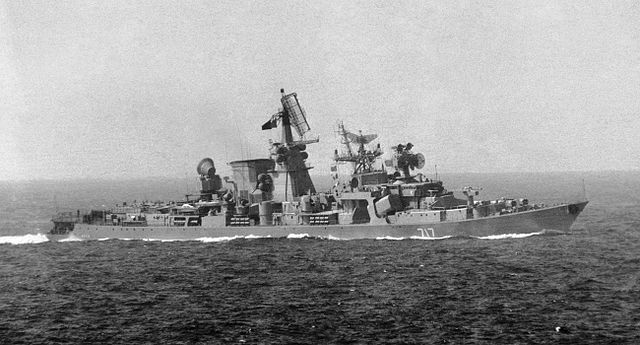
The Kara-class cruiser was a type of warship developed and operated by the Soviet Navy during the Cold War. The Kara-class cruisers were designed to provide long-range air defense for Soviet carrier battle groups, as well as to engage surface ships and submarines. They were armed with a variety of weapons, including 16 launchers for SS-N-14 Silex anti-ship missiles, 2 twin 76 mm guns, and a variety of anti-aircraft guns and missile systems. They also carried two Ka-25 or Ka-27 helicopters for anti-submarine warfare and search and rescue operations.
The Kara-class cruisers were in service with the Soviet Navy from the late 1970s until the early 1990s. A total of eight ships were built, with some of them being sold to other countries or scrapped after the collapse of the Soviet Union. They were really succeeded as ASW ships by the Udaloy class.
Design Development
Main tasks and requirements of Proyekt 1134B Berkut
The main purpose of the “1134 B Berkut” projected ships (as well as 1134 A Berkut) was to provide anti-aircraft and ASW defense to cover large formations of warships. They were “hunter-killer” ASW cruisers, tasked to searching, tracking and destroy submarines in remote areas of the seas and oceans. In practice thet were deployed against USN SSBNs as most probable potential enemy.
According to the tactical and technical assignment these were to be “large anti-submarine ships” and assigned the project number 1134-B (“Berkut-B”).
To this end, these new ships had to be part of the tactical groups of homogeneous and heterogeneous anti-submarine forces, giving them combat stability. To solve the assigned tasks, large anti-submarine ships were to equipped with modern detection and weaponry against equally modern (nuclear) USN submarines. The “Shtorm” universal anti-aircraft missile system was to be adopted as a fleet standard, covering the entire formation. Acting as part of naval anti-submarine groups in the absence of helicopter carriers or other anti-submarine cruisers, they were to be used as lead ship for ASW task groups. The combat core, around which all anti-submarine forces acted.
Initially, it was assumed that the Berkuts-B were to act in pairs together, and later in a combination of projects 1134-A (Kresta II) and 1134-B, and several project 61 destroyers (Kashin) as well as those of project 1135 (Krivak class frigates). These would have been attached to a small anti-submarine ship like thos of project 1124 (Grisha class) but since they had low seaworthiness and short range this was abandoned. It was rarely possible to observe more than one or two Kara or Kresta-Kara together most often only at large naval exercises. In service, their purpose has undergone a number of changes.
Design history of Proyekt 1134-B
In October 1964, the tactical and technical assignment for the project (TTZ) of an air defense ship with a boiler-turbine power plant was approved. The study was carried out by TsKB-53 within the framework of project 61bis-61A. After reviewing the draft design 61A in April 1966, the USSR Ministry of the Shipbuilding Industries and Soviet Naval staff made a joint decision to approve the main elements of the new air defense ship with a gas turbine power plant instead of a steam plant, and reinforced AAW missile and artillery weapons based on working drawings of for the large anti-submarine ship of project 1134-A, but with a number of design changes.
The development of a technical design of this new anti-submarine ship indexed as 1134-B, was entrusted to the Northern Design Bureau. Work began in May 1966 under the direction of V. F. Anikiev, appointed chief designer, and A. N. Kozhevnikov as his deputy. Captain 2nd rank O.T. Safronov became observer for the Navy and later replaced by captain 2nd rank M.A. Yanchevsky, then 2nd rank A.F. Nikolsky. In November 1967, the chief designer of the Northern Design Bureau, A.K. Perkov became the new chief designer with M.G. Golberg and V.A. Ivoilov as deputy chief designers.
The development of project 1134-B was attributed to the Northern Design Bureau team, with many subcontractors, research institutes of the industry, and the Naval staff. The final design was overviewed by the Commander-in-Chief of the Navy S. G. Gorshkov, which visited the Northern Design Bureau and was reported design progress, consulted with the bureau staff and leading experts on measures to improve combat and operational qualities. During such visits, decisions were made to clarify new design priorities and tasks.
Project 1134-B was developed while taking into account new regulatory requirements and rules for the design of soviet surface ships, adopted after the development of project 1134-A. The first working drawings were supplied by the design bureau to the construction plant in the fourth quarter of 1966. The technical design was finally approved on November 27, 1967. Before issuing a theoretical drawing, in agreement with the Navy in order to create a reserve of extra space (to add equipments in the future) and better accomodations, the ship was lengthened by two meters, with four inserts along the length of the hull and with a 500 mm extra beam.
Final drawings for the hull were completed mainly in 1967, and those for other modules were well advanced as designers managed to solve the long-standing problem of Soviet shipbuilding design bureaus, which was to develop combined and coordinated drawings excluding alterations during the equipments installation, systems and cablings with mutual overlap and lack of detailed installation dimensions.
In comparison with project 1134-A, main dimensions were increased. The hydroacoustic qualities were improved, and the anti-aircraft missile systems not changed much, but firepower was strengthened by installing a new Osa-M AAW system, replacing the 57-mm AK-725 artillery system and 76-mm AK-726. Promising the Shtorm B-192 universal air defense system of a new conveyor type, were also installed, and associated previous equipment partially replaced.
After reviewing the technical project, the armament was altered to receive 30-mm six-barreled anti-aircraft guns AK-630, coupled with an artillery fire control system MP-123 Vympel, and towed sonar station MG-325 Vega, with lowering variable depth antenna. During the finalization of the design, additions were made that were not provided for by the tactical and technical specifications: Systems were added for datalink between ships, target designation for weapons, Don navigation radar, Salgir complex, and a new electronic warfare and communications suite. Shaft lines and fairings for the GAS turbines received electrical insulation.
The consequences of a new gas turbines powerplant
On one hand, the positive experience gained in mastering gas turbine on ships at the 61 Komsomolets yard in Ukraine, as well as the potential capabilities promoted by Yuzhno-Turbine Plant (YUTZ), (officially called NPO Zarya) argued for an adoption for new steam-turbines cruisers. But the overload of the main manufacturer, Kirov Plant in Leningrad conducted to make another adjustment to the project 1134 Berkut for a gas turbine instead of a steam one.
The design of the new gas turbine ship, which received the project number “1134 B Berkut” was proceeded under the ditection of chief designer and observer, V.F. Anikiev and captain 2nd rank O.T. Safronov. This was carried out almost simultaneously with the 1134 A Berkut design. The tactical and technical assignment was issued to the Northern Design Bureau in 1964.
Adjusting the design from a steam to gas turbine means complete reworking of the machinery spaces, not to mention above architecture. The gas turbine plant is lighter than the steam plant, but still requires larger internal volumes mainly due to the large ducts. Excessive enthusiasm for fuel economy at that time led to the development of a very advanced gas turbine plant comprising afterburner turbines. Project “1134 B Berkut” to a large extent turned out to be a very new ship and urged a resizing of the hull, internal volumes and loads. The new ship still shared the same basic design as the Kresta classes, but larger and much reinforced with a deeper hull and better seakeeping.
The practice of using such installation showed they rarely sail using only their main engines. The main reason was a very low real speed under Gas Turbines alone, 14-15 knots, and and very limited cruising range, certainly under 9,000 miles. In general, combined gas-gas turbine units tested in the British Royal Navy in the 1970s and 80s proved their issues, going around many limitations, and such combined plants were abandoned. The effect obtained from such combined, complex installations also hand an impact on their cost and reliability. Diesel-gas turbine units became the norm in all navies, in different variations. In the Soviet shipbuilding industry, this was brand new.
Hence, the power plant designed for the 1134 B Berkut programme also had an important innovation, reversible gas turbines. These reverse gear, either was controllable by pitch propellers or more classic reverse gears. The smaller mass of the powerplant led to the need to change the hull’s dismensions and to install a funnel well separately from the tower-like radar mast. The huge funnel itself was a tribute to this new trend which supposedly made it possible to drastically reduce thermal visibility. Those promoting these apparently believed that the main surface detecting means were infrared systems and not radar.
Some Soviet scientists advanced that it was theoretically possible to bring ship’s thermal field to the background (sea) level but this proved unrealistic. It was just impossible to “deceive” infrared channel of anti-ship missile homing heads at the time. According to some experts, reducing thermal visibility was a cost-heavy enterprise. Only the USA and UK played with the sizes of gas nozzles, with gas turbines ships. The other approach chosen was always an active protection by blinding the enemy missile by chaffs.
Volume reserves due to the dimensions increase on Project 1134 B Berkut made it possible to strengthen the armament compared to the Krestas. A return to the large missile conveyor system and ammunition load of the Storm air defense system, was doubled, with 96 missiles. Additionally, two Osa/Oca-M self-defense air defense systems were installed, with retractable launchers. When loading, the launcher were lowered into the storage space below, and pulled another pair of anti-aircraft missiles onto its guides before returning automatically to its upper position, ready to fire. Hydroacoustic weapons were also improved with the new Titan-2T sonar for the first time as well as a towed sonar MG-325 Vega. Both assets considerably improved the Kara class capabilities. So even advanced that the Kara were twice as powerful as the Krestas.
Details final Design of the class
Hull and general design
Hull
The new Kara class had a standard displacement of 6,670-7,010 (6,700) tons, Normal displacement of 7,605-7,950 (7,630) tons and displacement fully loaded of 8,505-8,900 (8,565) tons. This compared well for example with the earlier USN Belknap class cruisers, displacing 7,930 tons (8,057 metric tons) fully loaded.
The hull had a maximum length overall at 173.2-173.4 meters (173.4) and waterline of 161.9-162 meters (162.0 m); Draught was 14.69-14.72 m (14.7 m) forward, 10.2-10.3 (10.3) amidships and 8.5-8.51 (8.5) aft. Average draft at normal displacement was 5.29-5.5m (5.3) and 5.7-5.9 (5.7) fully loaded. Overall draft with bulb fully loaded reached 7.78-8.16 (7.8)m. To compare again, the Belknaps ere shorter (166.8 m oa) with a much reduced draught (5.5m).
The GAS MG-332 “Titan-2” had two fairings, two 0.65-1.05 meters diameter propeler, a 0.4-0.5 steering diameter shaft, and the total height of the spars from the main plane, was 39.2m to 41.8m with the a 0.5 coefficient.
The use of another main power plant in project 1134B and introduction of new types of weapons led to a change in the overall layout compared to the prototype project 1134-A. Main dimensions increased in length by 12 m, in width by 0.6 m, the ship acquired an elongated forecastle, more developed superstructures (their volume increased by 38%), a tower-like mainmast and a massive funnel. The total volume of the ship reached 25,000 m³. There again, compared to a Belknap, it looked “elongated”, with a lower profile and more “spread” superstructures, a completely different animal.
The hull was completely welded from steel of various grades. The main construction material was SHL-4 steel. The hull set consisted of 326 frames spaced by 500 mm (19 in). The hull was divided by 14 main watertight bulkhead, making for 15 watertight compartments. The hull was composed vertically of three decks, the lower, upper and weather deck, and three platforms I, II and III from bottom to top above the weather deck.
The forward part of the hull was caracterized by a bulbous fairing for the new Titan-2 hydroacoustic station, which acoustic antenna had a 2 meters diameter (6.5 ft). Below the weather deck at the forecastle (the hull was flush with a “cut” at the poop below the flisgh deck) were two anchor fairleads, and near them sensors of the contact station for detecting submarines in a submerged position, according to the MI-110R contrast wake and infrared station. It was used to detect submarines by thermal contrast using the MI-110K wake. Behind them, on the upper deck, were the rigging pantry, boatswain’s and capstan. Perpendicular on the forecastle, were installed the customary pair of RBU-6000 rocket launchers separated by a special vertical screen for mutual protection from blasts. Behind them was located the B-192 bow launcher, Shtorm “universal air defense system”.
On the upper deck, were located behind a 45 seats mess and hydroacoustics cabin, command post, GKP-KPKS post, a bow power station, cabin for 23, radio equipment posts, four-seat midshipmen room, 14-seat mess, helicopter storerooms, hangar, midshipmen’s wardroom and directly under the runway, the space dedicated to the towed “Vega” towed array, with a crane and mecanism opening and closing the stern ramp, hydraulically driveen. In the tiller compartment was located the bakup steering system and boatswain’s pantry.
On the lower deck were located various pantries, posts, air defense control systems, automated control and stabilization, cellar for the aviation ammunition for the helicopter, notably containing AT-1 torpedoes, and avgas tank. On the second platform was located a forepeak, chain box, sonar posts, RGB-60 storage tooms and thos for thed V-611 missiles, pantries, refrigerators, radio equipment posts. On the first platform were located the foundations of the GTU M5 engines, forward engine room with two main engines and two GTG-12.5 gas turbine generators and aft engine room with four main engines and one GTG-6A generator. Between the engine rooms were located the stabilizers, and behind them was the aft section of gas turbine generators with two GTG-12.5A units.
Superstructures
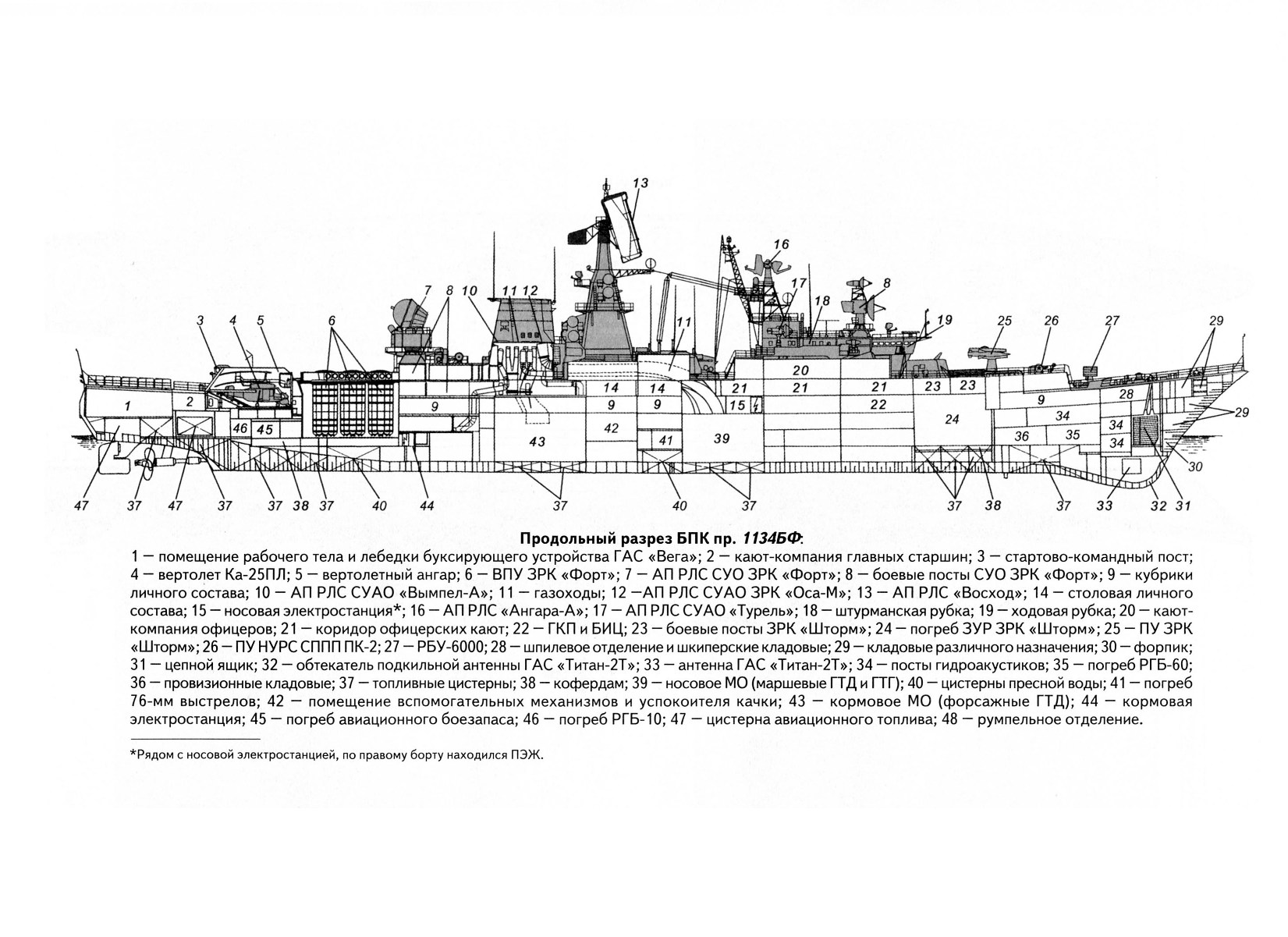
In stark contrast to the the Belknap’s clearly identified island superstructures, those of Kara occupied most of its length. They contained contains combat posts for various purposes, a secret office, bow emergency party post, gas ducts for the bow and stern engine rooms. The aft superstructure, starboard side, contained the duty room and next to it, premises of the sub-officers and upper officers’ cabins. The mess was located next the officer’s quarters.
Under the wings of the bridge, side by side, were located the same two quad launchers KT-M-1134A (KT-100), for anti-submarine missiles URPK-3 “Metel”. The fourth ship in the series, had on the superstructure deck, in front of the wheelhouse, the Tsunami-BM space communications system was installed as well as the Shtyr-2M ship navigation system. Duringe modernization, the Tsunami-BM system was also installed on the cruiser Kerch. Above this were located the two 45-mm salute guns 21-KM. Above the navigation bridge were located the antenna posts, Don and Volga radar stations with the antenna post of the second Volga radar installed in the upper part of the main mast, back. The forward antenna post had the SU “Grom-M” installed, with inside the mast, the stabilized post for the television system, monitoring near-surface situation coupled with the MT-45N, optical periscope sights (main command post and navigation bridge).
The stern superstructure comprised a small MP-310A combat post made of aluminum-magnesium alloy for stability, with a four-legged lattice foremast and antenna for the 3D radar station MP-310A in its upper part, antenna post for the radio direction finder ARP-50R. Under the superstructure was the cabin for the commander of the ship and flagship facilities and cabin, on the same deck with the navigation and navigation cabins for rapid access. Onboard the foremast were located the antennas of the MR-105 “Turret” radar placed to control AK-726 AU fire. On the superstructure deck were also located the officers’ wardroom and, next a cabin for the senior assistant commander (XO). Behind the wardroom was located a large air duct shaft for the bow engine room, and behind the gas duct room (with extra insulation) and newt to it side platforms for the AK-726 guns, in front of the base of the mainmast.
Further to the stern, was located the tower-like main mast, with six faces with below combat posts and radio room and associated equipment. The S-2003 was located on a special platform mounted on the fourth tier of the antenna post, with the Koltso detection radar, and the radio countermeasures control station. The radar itself and its antenna post were different on Kerch. On the side walls of the main mast were located the usual dual spherical antennas of the MP-150 Gurzuf-A and Gurzuf-B (“NATO bowl”) electronic warfare stations, S-2001 and S-2002 and MRP-electronic intelligence stations, 15-16M “Zaliv” MRP-11-12, and MRP-13-14 systems. The mainmast top was crowned by the large MR-600 Voskhod radar antenna.
Thanks to original reinforcement for it an intense air flow was created in the upper part of the gas outlet pipe located nearby, which, in addition to additional cooling of the exhaust gases, created favorable temperature conditions for the operation of these electronics. Gas ducts of the gas turbine were truncated into a single sauare funnel separated from the main mast. Close to it were located two batteries for two six-barreled 30-mm AK-630 autocannons and guiding MP-123 radar. Aft of the funnel were attached the antenna post for the second Grom-M radar and B-192 aft launcher, Shtorm SAM. On the poop deck, side by side were located two PTA-53-1134B quintuple torpedo tubes.
In the aft part of the superstructure was installed the semi-recessed helicopter hangar, with two side-opening doors and rising roof. On the poop deck, abaft the hangar, two RBU-1000 ASW RL were installed. Behind the superstructure the helicopet command post was located, and helicopter landing pad.
Powerplant
The main power plant “Berkutov-B” consisted of two gas turbine units M5 (on “Nikolaev” and “Ochakov”) or M5E (all other ships). Each installation consisted of two main engines, one sustainer and two gearboxes. In the GTU M5 gas turbine, non-reversible engines DO54 were located, with an output of 18,000 shp, using as the main power source. They were follwoed by the DO61 reversible turbine section, with a capacity 6,000 liters. The GTU M5E main engines followed, with non-reversible DE59 turbines which output was 22,500 hp. They were coupled with a DO63 reversible section with a capacity of up to 9,000 liters.
Composition and gearbox
The gas turbine included main two-stage reversible gearbox RB54 capable of providing pairing main engines for an output shaft speed of 280–300 rpm. When the main engine were operated, main shaft clutch was turned off, the main gearbox turned off as friction-cam clutches were activated. Autonomous operation of the propulsion engine various combinations between the main and secondary engines were provided felxibility due to the two-speed, three-stage, non-reversible gearboxes RO63. Output shaft speed in 1st speed was 180-220 rpm, in 2nd 300 rpm. In sea trials at full forward speed, the ensemble could produce up to 86,700 or 102,800 hp. Again, this was comparable or better than the Belknap class (83,000 shp) which used classic steam turbines. Thus, the Kara class had more engine flexibility.
Performances
Performances-wise, their COGAG ensemble (4x DN59 2x DS71 gas turbines) could produce an output evaluated by NATO up to 120,000 hp (89,000 kW), for a top speed of 34 knots (63 km/h; 39 mph) and Range of 9,000 nmi (17,000 km), far better than the Belknap’s (32 kts and 7,100 nmi/20 kts).
Thermal/Acoustic reduction
In order to reduce the thermal signature of the Kara class, gas-air coolers and outboard water injection systems were provided to cool the gas streamn above the gas ducts of the main engines. Silencers for acoustic signature were also used, located at the intake and exhaust from the main turbo-gear units, and gas turbine generators. However the main turbines were not placed on rubberized legs or damping suspensions as in submarines to reduce vibrations. The four auxiliary engines were grouped into independent units, and those were, unlike the main turbines, installed on suspended platforms to reduce their hydroacoustic signature, notably to avoid interfering on the ship’s main sonar at search speeds.
Other equipements and maintenance
The main power plant included also the remote automated control system for the main turbo-gear unit “Typhoon”, a protection gear and governor for the main units M5 “Samum”, a remote control system the centralized control M5E “Pamir-2” or “Pamir-2M”. Management and control for the powerplant was provided by a central control room and remote automated control system. Power distribution to the main and secondary engines ensured rational gas turbine use in various travel modes, reducing greatly specific fuel consumption by sheer regime optimization. The main engines were guaranteed for 6,000 hours or six years of uninterrupted use before a major refit, and for the main engines, 20,000 hours of operation, also six years.
Steering system and agility
The steering system comprised semi-balanced steering axis, with REG-8-3 steering engine and Albatros 22-11 autopilot (on Tallinn it was the Aist-23-20). The propulsion consisted of two bronze four-blade, low-noise propellers. In the years 2000s for the surviving Kerch, new five-blade supercavitating propellers were installed after her overhaul, greatly reducting cavitation and acoustic signature.
The time needed for a complete stop by reversing the shafts from a “full astern” was 122-160 s, on a distance traveled of 4.9-5.1 ship lengths. Time for a complete stop from “full forward”, to full astern was 80-105 s, on a distance of 1.7-2.6 ship lengths. The turning circle at full forward speed 35° hard rudder port or starboard, normal displacement, was 4.6-5.9 ship lengths, and maximum roll angle was 8°-10°. Minimum forward control speed was 5.0-5.5 knots.
Electric power plant
The electric power plant included four GTG-12.5A gas turbine generators, coupled with a GTU-12.5A drive engine guaranteed for 20,000 hours, and a MSK-1560/1500 generator rated for 1560 kW (on Tashkent and Tallinn, 1250 kW). There was one gas turbine generator GTG-6A or GTG-6I to ensure operation of the hydroacoustic station in a pulsed mode, consisting of a drive engine GTU-6A or GTU-6I guaranteed for 20,000 hours, and a MSK-750/1500 generator rated for 750 kW (For Tashkent and Tallinn, 600 kW). They all produced an alternating three-phase current of 400V, with a frequency of 50 Hz. The management of the electric power was autimated thanks to the Angara-B remote automated control system, managed from the central powerplant control room.
Fuel and Autonomy
The transfer of fuel and supplies on the move at sea (RAS) was carried out using four flexible hoses located symmetrically on the starboard and port sides, making it possible to transfer all the needed fuel at a rate of 200 tons/hour so in 3-4 hours in normal sea conditions. Water intake was carried out at a rate of 20 t/h, dry cargo at 5 t/h. In total, the ship had seven fuel receivers with (diameter 150–200 mm), two boiler water receivers (50 mm diameter) and three drinking water receivers (diameter 50 mm). The Kara class were also equipped with two booms, with a lifting capacity of 3 tons each, and two portable cargo beams with a carrying capacity of 250 kg each. Autonomy was 30 days for water and fuel, 45 days for provisions without rationing.
Life aboard
The crew of the Kara class cruisers consisted of 49-52 officers, 62-64 midshipmen and 311-319 enlisted personnel (lower ratings).
The commander and senior assistant (CO-XO) were accommodated in separate single cabins and ship’s officers comprised five single block cabins including two “admiral’s” with all amenities, and 21 double cabins, one triple and one four-bed cabins. The officer’s wardroom (mess) had 44 seats, the midshipmen’s mess had 32 seats. The Midshipmen were accommodated in two doubles, four four-bed, two five-bed, one six-bed cabins, as well as nine- and ten-bed rooms. Extra sleeping mast were provided for 54 officers and 64 midshipmen when training. There were also extra space for the flagship staff. The rank and files lived in 12 separate rooms with superposed mats, enough for 320 (from 15 to 54 rooms). Ratings had regular folding berths. Lower officers and ratings were provided food in two shifts, in the main ship’s canteen of 150 seats. The officer’s quarter had a dedicated chef, galley, and dining room. There were also cinematograph rooms for the officer’s and men’s entertainment and information, notably used by the political commissar.
Medical care was provided in the medical block, including an operating block, outpatient clinic with dental chair and equipment, infirmary with four beds, reception room, sterilization room, isolation room for two beds, medical pantries.
Buoyancy and Stability
The Kara class usage of its ASW RLs is possible at sea in waves up to 5 points, wind speeds up to 20 m/s, roll 12° to 15°, trim 5° to 8°. It is supposed to float even when three adjacent compartments are flooded. Buoyancy reserve is of 13,340 up to 13,485 tons, and stability, provided with an initial transverse metacentric height of 1.0 to 1.11, 1.45 to 1.57 and 1.53 to 1.87.
Various equipments
Anchoring system: It included two four-ton Hall anchors, two anchor chains with 46 mm thick links, 300-350 m long, weighting 16 tons, as well as two electric anchor-mooring capstans ShE-29. Time for complete chain laying was 18 minutes. Mmaximum anchoring depth was 100 m (For Tallinn, 120 m).
Communication Suite:
The Kara class were equipped with six radio transmitters, fourteen radio receivers, thirteen shortwave and VHF transceivers. After order S-2004 upgrade as well as after reepair under S-2003), they received the R-790 Tsunami space communications equipment. Visual communication included signal lights and searchlights: Two MSNP-250M, two MSNP-125 and two MSL-L45/2. For operation of the Berkuts-B binocular periscope sights VPB-454 and VPB-451, two sets each, were also installed.
Radio equipment
The Kara class has a high saturation of radio-technical environment and was provided 22 main antenna posts. The volume of radio-technical and weapon control systems occupied 59% of the total volum so to ensure electromagnetic compatibility, the Zvezdochka-1134B system is installed.
Chemical Protection
The Kara class were fully NBC protected. Project 1134-B vessels were proof for chemical weapons as the project 1134-A (Kresta) ships, with a universal water protection system USVZ (one sprinkler set), three winter special treatment KSZO sprinlkers. All external hatches and door had special sealing, there was a sanitary-chemical SHB unit, 12 degaussing kits KDK, 5-9 filter-ventilation units FVU, 27 absorber filters, a KDU-4 dosimetric, automatic air conditioning system, six radiometers and other equipments for radiation detection.
Drainage and fire fighting equipment:
Fire protection included 14 stationary sump pumps NTSV-315/10, six portable sump pumps ESN-16/P, stationary and portable sump ejectors with a capacity of 10-30 tons/h, with four such ejectors, later increased to nine stationary and 11 portable ejectors VESh-21 in active service. The aluminium allow for the superstructures also needed special treatment, notably coating and dedicated autimated sprinklers. There were thermal detection systems in the power unit, ammunition, avgas, and missile compartments with automatic sprinklers as well.
Five SO-500 fire extinguishing systems located in strategic places were completed by two ZhS liquid fire extinguishing stations, eight NTSV-160/800 electric fire pumps, an automatic fast-acting sprinkler in the ammunition magazines, automatic inhibitor system as well with the Onega-15 control system, automatic switching system fire extinguishing in the “Karat” and later “Karat-M” ammunition rooms.
Crew Safety-evacuation, survival
The Kara class cruisers also were given a project 1390 command boat each with a capacity of eight, a project 338PK working boat large enough for 20, a P-6 six-oared yawl (13 seats). The Rescue equipment comprised 36 ten-seat life rafts PSN-10M and 30 life buoys PKhV-1, and many life vests in extrenal bins at weather deck level.
ship stores:
In the double-bottom space 36 fuel tanks were located, with a main 22 tons oil tank, and 15 tons boiler water tank. Fresh water was located in three tanks, one 22.6 tons, one 44.5 and on of 75.4 tons respectively.
Armament
Defense Systems
Storm anti-aircraft missile system (SA-N-3 ‘Goblet’)
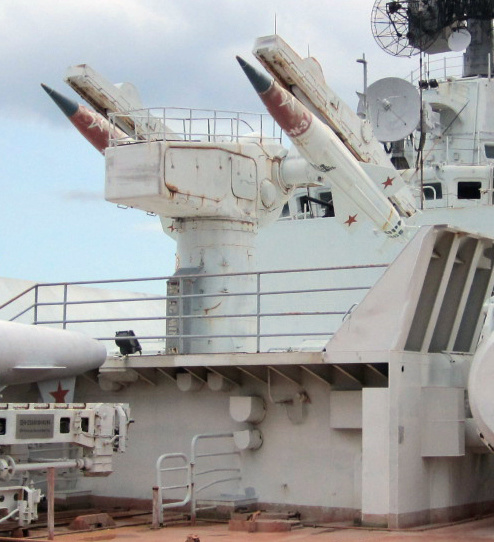
Project 1134-B ships are equipped with two SAM launchers of the M-11 Shtorm universal anti-aircraft missile system (later Shtorm-M, Shtorm-N). The launching system was designed specifically for this project, with a B-192 conveyor type, making it possible to increase ammunition capacity to missiles, in two rooms fore and aft. The Launchers in the bow and stern, on the superstructure deck had twin stabilized arms and pedestal-type installation, with a lower guide beams, which can elevated to 130°, or 150°. Each salvo of two missiles could be perform with a firing interval of 50 seconds, for the 4R-60M “Grom-M”. The bow “Grom-M” fire control URPK-3 “Metel”, after modernization comprised URK-5 “Rastrub” units.
Performances: The Shtorm is a short range weapon, with 6-33.5 km over sea range, and 0.1-25 km ceiling. Subsequent upgrades Shtorm-M in 1972 and Shtorm-N, 1980 made it possible to intercepot even missiles at much lower range, and enabled pursuit firing at maneuvering targets, Shtorm-N being even a more apt low-flying anti-ship missiles system.
OSA-M antimissile systems (SA-N-4 ‘Gecko’)
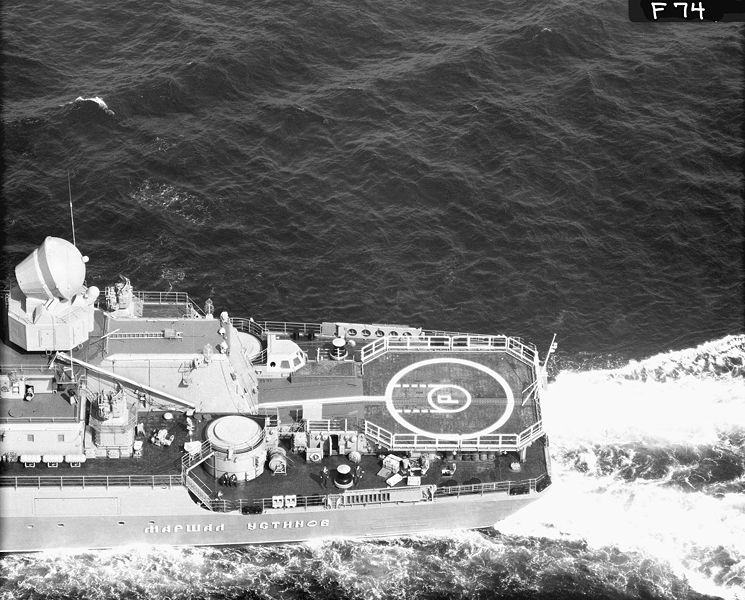
To destroy air and sea targets at even shorter range, the Osa-M air defense system was installed in two side mounts located amidhsips. They had a 15° elevation and 18°-165° traverse on each side. Rate of fire for air targets is 2 rounds per minute, and for surface targets 2.8 prm, with a range from 1.5 to 10 km, and 0.05-5.0 km ceiling. Target detection was carried out by the 4R-33 radar (two sets), providing target detection at altitudes up to 4000 m or at 25-30 km distance, high altitude ceiling up to 50 km. The mounts could received pointing data and target designation from shipborne radars. 40 missiles are provided in all.
ASW Weaponry
URPK-3 “Metel” (NATO SS-N-14 ‘Silex’)
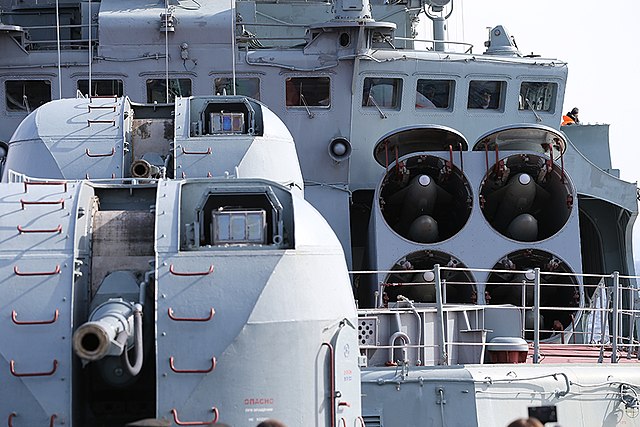
Main anti-submarine weapon for the Kara class (1134-B) common to project 1134-A (Kresta II) was centered around the second-generation anti-submarine missile system in service by 1973. It consisted in two four launchers, non-guided fixed deck canisters KT-M-1134A systems (KT-100 container) located on either sides under the wings of the navigation bridge. Ammunition was not reloadable, and consisted in eight guided anti-submarine missile coupled with 85P, 533 mm (21 in) torpedoes similar to the ASROC system but much larger.
Range is 6 to 55 km for the carrier missiles, while the homing torpedoes AT-2U are limited to 8 km, but they are acoustic. Flight speed is Mach 0.95, torpedo speed in homing mode after target acqusition is 25/40 knots (75 kph). The torpedoes could receive a conventional explosive charge or nuclear warhead if needed.
The onboard flight control system of the URPK-3 missile is slaved to the fire control of the Grom-M anti-aircraft missiles and M-11 Storm bow anti-aircraft missile system. The missile system is provided data from the Tyulpan pre-launch automation equipment. Firing interval is 6 minutes to avoid interference but simultaneous salvoes of two missiles possible using both canisters. Reloading is not possible at sea but in port, with a floating crane. The anti-submarine missile system is possible in heavy weather up to 15° pitching and 5° rolling, or sea state 5 points, wind speed 20 m/s. In the 1980s, modernization enabling the adoption of the more advanced URK-5 “Rastrub” (see later).
RBU ASW Rocket Launchers
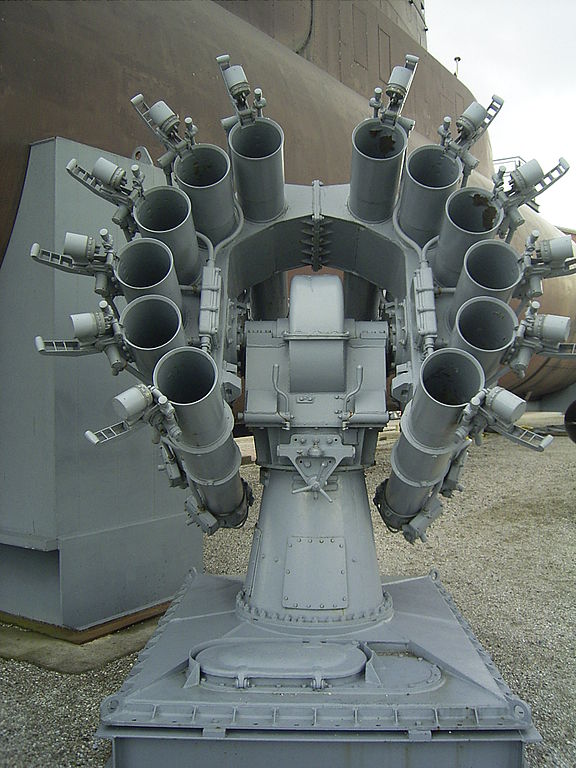
These systems are intended to destroy enemy submarines at short range (it’s the soviet modern Hedgehog) or incoming torpedoes. It includes two forward twelve-barrel launchers RBU-6000 “Smerch-2” and two aft six-barreled launchers RBU-1000 “Smerch-3” aft. Firing angles for the RBU-6000 starboard are 325°-0°-137°, and port side 223°-0°-35°. Firing angles of the RBU-1000 starboard are 15°-180°, and port of 180°-345°. Elecation are -90 ° to +65 ° for all mounts at a pointing speed of 30°/s in automatic mode.
Ammunition for the RBU-6000 consists of hundred and forty four 212-mm 119.5-kg RSL-60 rocket in all. They are stored in vertical reload racks, barillet type, ready below. Reload is thus made at 90° angle. Ammunition for the RBU-1000 consists of sixty 300-mm 196-kg rockets RGB-10. They are operative at sea waves up to 8 points. RBU target designation is determined by sonar stations, transmitted by the PUSB system, for automatic pointing.
Torpedo armament
Another “classic” buit sill important asset on board, both usable for anti-ship use as well as ASW, are the two quintuple torpedo banks on either side, located aft on the weather deck, with recesses in the superstructure to enable a 250° traverse. They were intended initially to destroy enemy submarines in a 6-8 km perimeter. The PTA-53-1134B five-tube torpedo tubes units represent a total load of ten 53-65K and SET-65 torpedoes. A volley could be fired in either 2-4-5 torpedoes simultaneously. Standard configuration inclused six (or four per bank) 53-65 torpedoes and four SET-65 torpedoes. Firing angles in traverse are 60° forward, 50° aft. No reloading at sea or spares are provided. The torpedo firing control system is the Typhon-1134B. The use of these TTs is possible with a sea state up to 5 points, wing speed of no more than 60 knots.
Artillery
AK-726 Turrets
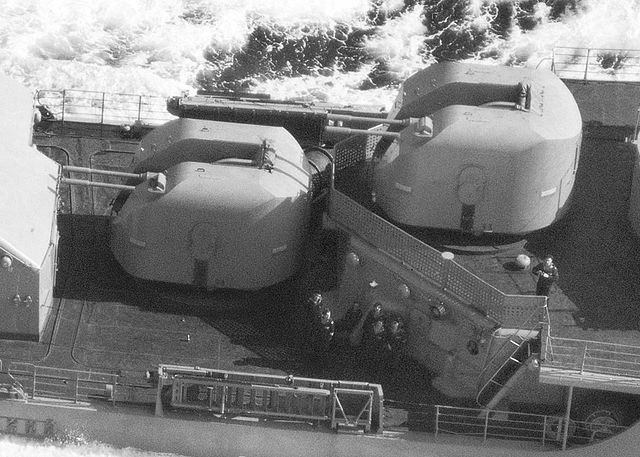
Main caliber aboard, the two 76.2-mm twin-gun automatic guns turrets AK-726 are located amidship on platforms between the mainmast and foremast. They are assisted by two firing control stations MP-105. They enable all-purpose artillery fire air/surface/coastal. Ammunition use for a total of 2400 rounds, at a range 13 km (air), and for sea/coastal targets 15.7 km. Rate of fire is 90 rounds a minute. Continuous burst of 40-45 shots is possible. The guidance could be local (as backup) or remote from the firing control MP-105 Turret.
AK-630 Turrets
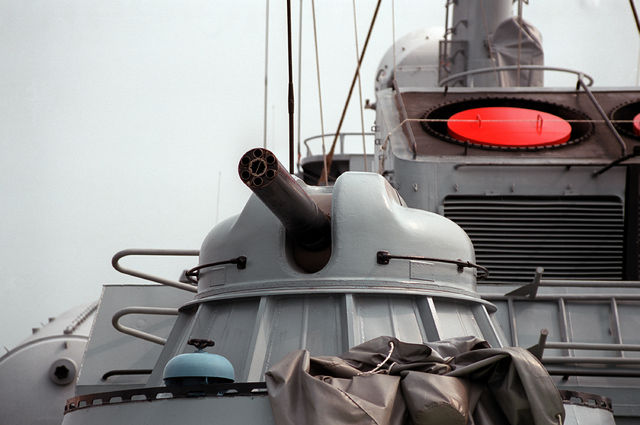
Small-caliber anti-aircraft or anti-missile artillery comprised two CIWS batteries, 30-mm six-barreled automated artillery mounts, with four systems installed, on a bandstand abaft the funnel aft.
Total ammunition capacity is 2,000 rounds for each one, thus 8,000 in all. Maximum range is 8,100 m or 5,000 m ceiling.
Onboard Aviation
The other impportant, ported ASW component of the Kara class, like for the Kresta-II, are its single permanent Ka-25PL helicopter. It is located on the deck aft in a semi-recessed type hangar measuring 12.5 × 4.8 × 5.5 meters. Inside the hangar there is a PVN-9000/2 crane to lift or lower the helicopter, enabling the maintenance mechanics to work more easily. The poop spot is 11.5 × 10 meters with its spot itself fully bulb-illuminated for night operations. A starting helicopter command post with air and surface conditions display is located in the upper area of the hangar, under glazing, similar to the Kresta II. The spot is also equipped with short-range navigation/landing optical guidance systems, and R-653 radio. The hangar has a full helicopter maintenance suite with spares and workshop.
The Ka-25PL helicopter is capable to operate for SAR and liaison missions but it’s primary duty is ASW detection, shadowing and attack. In total, the ship is provided six aircraft torpedoes, four PLAB-250-120 bombs, eight PLAB-50 bombs, two Ryu-2 special nuclear depth charges, and between 54 to 72 RGB-NM “Chinara” and 15 “Float-1A” detection buoys, airborne naval DCs OMAB-25-12D and OMAB-25-8N. Ammunition, service posts, storerooms and workshop are located in the premises adjacent to the hangar.
Fire Control Systems
Missile and artillery Control
There is a group stabilization systems (gyroazimuths) “Nadir-1134A/B”, four sets for the missiles, target designation systems and “Stvor” coordination and safety system for simultaneous and safe use of all weapons aboard.
For passive radio countermeasures, the PK-2 system is provided, as well as the single set high-speed acoustic guard BOKA-DU and single demagnetizing URT-860 or URT-860M system (working at 360 V, 64 kW, 128 A). The PK-2 chaff systems comprised a double-barreled reactive set for passive interference ZIF-121, 140-mm and two sets “Tertia”. The TSP contermeasure chaff system comprised 80 D1 units and 60 D2 units as well as 60 DO-60. The chaff Launcher had a firing angle of 10° port and 168° starboard. Target designation is provided by the Alley-B system or MVU-202 and MPTs-301 depending on the ships. On Petropavlovsk when upgraded at Dalzavod in 1985-1989, an extra PK-10 complex (with 8×10 122-mm launchers was additionally installed.
Radar stations
The ship was equipped with a 3D early warning radar station MP-600 Voskhod with a detection range of air targets up to 500 km (low-flying – 50 km), and sea targets up to 50 km. The station is highly protected against active and passive interference, ensuring electronic suppression from almost all the means available in the world at the tilme, to the except for the electronic warfare equipment of the American Grumman EA-6 Prowler.
When undergoing modernization in 1987, the Kerch received the new 3D ultra-long-range radar MP-700 Podberyozovik. The backup station for the Voskhod radar is the MR-310A Angara-A general detection radar. The station is interfaced with a computerized information processing system ensuring detection of air targets at ranges up to 200 km, sea targets at ranges up to 40 km, as well as automatic tracking of up to 15 targets simultaneously.
The Navigation stations “Volga” and “Don” 3-cm range could detect surface targets at a distance of up to 30 km at sea, and in the air up to 50 km. The navigation radar “Don” is a backup installed on the cruisers as safety complement.
Sensors Suite
Underwater detection stations
The MG-332 “Titan-2” underwater sonar station is the pnboard the main hydroacoustic station, installed on the first two shipss, alternative to the MG-332T “Titan -2T” with improved performance for the others, mounted in the nose bulb fairing. It operates in echo and noise direction finding mode and is intended to detect and determine coordinates of submarines, as well as to issue data to the anti-submarine weapon control posts, missiles, torpedoes and RLs. Actual detection range is about 2-10 km, although the press published data of 20-32 km. It worked in circular or sector search modes.
The MG-325 Vega is the complementary towed sonar array, located at the poop. The long flexible antenna could be lowered down to 100 m, and features detection range of 2-25 km (actually up to 15 km), and could work in all hydrometeorological conditions and at high speeds (25 knots).
The MG-26 Khosta station is usable for underwater communications and identification (IFF) of submarines or incoming underwater targets.
The Kara class were also provided with the “Raygraph” MG-33, analog builder of acoustic illumination zones, taking into account vertical distribution of sound speed, with the associated displays, in several modes.
On the cruisers Tashkent and Tallinn were initially installed two sonar detection systems for underwater saboteurs in the anchor mode MG-7, later ported on all other ships, to avoid “foul play” at anchor in foreign ports. Antennaes of the bow and stern sets for the MG-7 were stored on the upper deck, and lowered into the water with the help of a cable-layer. At the same time a watch was opened to monitor the underwater situation to friendly combat swimmers inspecting the ship’s hull and surroundings.
The hydroacoustic suite also comprised a contact station for detecting submarines by thermal wake contrast MI-110K, an infrared station for detecting radiation contrast wakes MI-110R. The MI-110KM station was installed at the end of their service.
The Kara class also receiving and indicating communication equipment assoviated with the MG-409K radar sonar buoys. This comprised a set of television equipment for reflecting near surface conditions. On Tallinn and Tashkent, this was a MGS-407K receiving post.
Onboard Electronic System and CIC
The Kara class were also equipped with automated control systems (ACS) constantly improved over time, modernized, expaneded throughout their active life, this led to changes in their composition, mutual transfer of some functions of one system to another and increase in general automation. On the first two ships of the class, Nikolaev and Ochakov, it included a ship-based electronic system for auto-detection, radar data processing, target designation for the Baikal-C4 suite and data bus, mutual data exchange between ships, including target designation broadcast withing the tactical group using the “Alley-1134B” system, duly encrypted. It is central to the Kara Tactical combat information and control system Root-1134B charged of the collection, processing and display of informations in the COC providing instant recommendations on naval weapons coordinated use.
On the remaining five ships, the Root-1134B CIC is replaced by the MVU-202 marine computing device, a central, unique automatic system for collecting, processing information, target designation and control. The big drawback of the latter system is manual input, whereas the CICS is digital, and all shipborne radio-electronic systems are analog, creating massive problems over time. The tactical MVU-202 communication was found to be unreliable in general. The Alley-1134B system installed on Kerch and Azov only whereas Petropavlosk, Tashkent and Tallinn had the MVU-203 instead. The Baikal-S4 system of Kerch and Azov was replaced by the MPO-410A on Petropavlovsk and MPO-400 on Tallinn and Tashkent, processing radar information with simultaneous tracking of 15 targets and issuing target designation for six at the same time.
Rocket and artillery Target designation system for the first two ships were the MR-600, MR-310A, Root-1134B, Baikal-S4 and reserve target designation MPTs-301 for air defence, as well as the PK-2 target designation system and for the URPK-3 “Metel”, MG-332 and Root-1134B. The helicopter remote post was assisted by the MP-310A, Baikal-S4 and Root-1134B. Torpedoes were managed by the MG-332 also responsible for the “Sgtorm-1134B” and “Typhon-1134B” system, and submarine group attacks “Dozor-1”.
Electronic warfare equipment comprised on the first two ships the radar and direction finding stations MRP-15-16M “Zaliv” and two sets of MRP-11-12 and MRP-13-14, capable of detecting and finding enemy radars in operations, and determining their working parameters. Kerch and subsequent ships had the optional radio countermeasures “Koltso” system but the antenna posts were reserved when not installed.
Active electronic warfare for response, frequency-targeted, masking, simulating and diverting interference in coastal or aircraft detection, weapon control, radar homing for cruise missiles with frequency agility are provided by two stations using response interference MRP-150 “Gurzuf-A”. They could operate with VChS (high-frequency noise), MOD (repeated response in range), UD (leading in range), LFSH (low-frequency noise, leading in angle) and combined (modes). In addition to these, there was a single R-740 radio interference station and single R-743 station fer similar purpose also installed on all ships.
For radio reconnaissance and radio interference (control, signal recording, interference control) and tape recorders were provided as well as the IFF identification systems Nickel-KM (4 sets) and Nichrome-KM (2 sets). One one cruiser after refit, a Spektr-F laser radiation reporting system was installed.
Navigation equipments includes two Kurs-5 two-gyrocompass sets, the magnetic compass UKP-M3 (later MK-127) two log MGL-50M sets, the autoplotter AP-4-1134B, the echo sounder NEL-5 or NEL-10, the radio direction finder ARP-50 and up to 12 sets of various receiving indicators. There is also the ship wind meter KIV, the infrared equipment for night joint navigation Fire-50-1 and four navigational sextants.
Construction, trials and modifications
Construction and launching specifics
The construction of these large anti-submarine cruisers was carried out at the 61 Kommunars in Nikolaev (Ukraine) on the black sea. The choice of this yard was due to the company’s experience in building the world’s first gas turbine ships, project 61 ASW ship, as well as relative proximity of the main Soviet gas turbine engine manufacturer, Southern Turbine Plant. The lead ship was laid down on the second slipway. The laying of the next ones was carried out after the launch of the previous ones, same day, same slipway, ensuring continuous delivery. Construction time on slipway lasted from 10.5 months to one and a half years. It was carried out in a block way, taking into account assembling peculiarities of the sections, which were prefabricated, and assembled on an inclined slipway. Great care was placed when joining blocks and sections, lowering them on the slipway, connection carried out by performing a single block annular seam using automatic welding.
The lead ship (S-2001) needed the invention of 22 mm thick shields instead of the usual greasy slipway skids, using an innovative special anti-friction plastic material “PM”, on which a thin layer of CIATIM-201 aviation grease was applied. The use of such shields during launching made it possible to significantly simplify and reduce launching costs.
The Project 1134B hulls were launched without the large nose cone of the Titan-2 hydroacoustic sonar. It’s fairing with the Khosta hydroacoustic station was mounted later, as the propellers to avoid damage during descent. Their installation was carried out in a special docking facility at the yard and in two stages: The bow was docked, resting in the floating dock, while the stern was kept afloat with the help of additionally wound up pontoons. The ship was then taken out of the floating dock, a new set of keel blocks for the stern installed while the bow was supported by pontoons, for the propellers to be installed in the drydock. The bottom was painted in the same way, all because the short floating drydock.
Yard and official tests
After the dock work was completed, mooring tests were carried out for all systems to be powered up for the first time, all devices and mechanisms checked ate berth. The next stage was the shipyard sea trials, which included adjustment and check of all systems on the move and first fire tests, using blank for the strength and vibration tests.
The last step were state trials, with a complete review of all tactical and technical elements for compliance with the requirements and standardsof the Navy. The lead ship underwent extra heavy weather trials. In the process of state tests, main engines were used in all configurations, as well as auxiliary systems, the automation and electrical equipment, power reserve in combat mode, full speed, operational, economic speeds, cruising range, maneuvering characteristics, and with constant cheks of readiness of the missile and radars along the way, plus their uses in all modes with target practic drones ro test detection and identification of air and sea targets, and verification of the accuracy of target designation and data. Fire control for the anti-aircraft artillery were also checked. It was found that the shipbuilding quality was met, reaching all technical requirements. However it was observed frequent missile launcher failures in part examplained by loose tolerances and low quality of some ammunitions, causing jammings.
The final stage of the state tests was a comprehensive tactical exercise, to determine the ability of each Kara class cruiser to search, track, attack a submarine whereas repelling attacks by aircraft, missile and torpedo boats. Tactical exercises comprised notably the attack of a test project 613 submarine (Whiskey class) with the RBU-6000 air defense from the bow and stern SAM “Shtorm” at radio-controlled targets La-17MM at low altitudes, rocket firing at the parachute target PM-6, operating against a fixed and mobile sea target, close-in defense with the Osa-M and artillery accuracy from the AK-726 on a moving sea target, firing the PK-2 decoy system and NBC survivability/protection drills and tests.
In all, between the keel-laying and completion of state test, commission of the ship, total duration ranged from three years and one month to four years and one month, the longest being Tallinn, and the fastest Tashkent with three and a half years on average, at the global cost of 67 million rubles. In 1969 when was launched Nikolayev, the USSR had its most advanced, costliest, largest guided missile class of ship ever. The last ship, Vladivostok (ex-Tallinn) was commissioned ten years after, in December 1979. They had thus “only” between 18 and 11 years of active service between the collapse of the USSR, but were taken very seriously by the USN and NATO submariner community as the ultimate “sub-killer” of the Soviet block. It should be recalled that the USN separates well the roles between ships types, as the primary role of their cruisers at the time was AA and surface defense. ASW tasks were left to shorter range frigates, and to destroyers as secondary task.
So having a so capable, powerful ASW cruiser was something new.

Author’s rendition of the Kara class
⚙ Project 1134B specifications |
|
| Displacement | 6700-7630t, 8565t FL |
| Dimensions | 173.5 x 18.50 x 5,32m () |
| Propulsion | 2 shafts CODOG, 2+ 4 Gas turbines, 120,000 shp. |
| Speed | 32-34 knots () |
| Range | 9,000 nmi/15 kts |
| Armament | 2×4 SSN-14, 2×2 SAN-3, 2×2 SAN-4, 2×2 57mm guns, 4 CIWS 30mm, 2×5 353mm TTs, 2x RBU 6000, 2x RBU 1000. |
| Helicopter | 1x ASW Kamov Ka-25 Hormone. |
| Sensors | Radars 2 Don Kay, 1 Don 2, 1 Top Sail, Head-net C, 2 Head Light, 2 Pop Group, 2 Owl Screech, 2 Bass Tilt. Blue Nose Sonar, Mare Tail, 8 CME Side Globes, 2/4 Rum Tub |
| Crew | 380 standard, 420+ flagship/cadet TS |
Modernization History
Unlike their predecessors the “large anti-submarine ships” projects 1134 and 1134-A, the new 1134 “Berkut-B” had a great modernization potential due to their largest size. Circumstance took into account the TsKB-53 Northern Design Bureau and later Southern Design Bureau initial studies, with already planned more than 50 studies options for weapons and sensors swapping. Their career from the 1970s to the 1990s (20 years) comprised many upgrades.
Early modernization and alternative projects
The antiship modified Kara class
In 1971, the Commander-in-Chief of the Navy S. G. Gorshkov proposed a project for a new ship with better antiship capabilities rather than anti-submarine one, by simply replacing the URPK-3 Metel with the P-500 Bazalt anti-ship missile system (SCRK). Under the leadership of V. D. Rubtsov, several variants of such Kara variant were developed. One of the options was an enlarged 1134-B with the hull length increased by 13 m, 2.3 m in beam and 2,700 tons more in displacement). Designers with this jumboisation managed to place eight launchers with the P-500 SCRC in single side by side canister, in the same fashion as the latter Slava class. The dimensions of the launchers exceeded the dimensions of the previous quad Metel launchers by far.
Another modernization option went for not only an increase in dimensions and displacement, but removing altogether one of the Shtorm SAMs, the two torpedo tubes banks, the two RBU-1000 rocket launchers and the helicopter, freeing space to add more P-500 launchers, this time in pairs at the stern, for a total of 12, two twin pairs for and aft on either side. The Slava class, which derived from these studies, would have all four pairs forward.
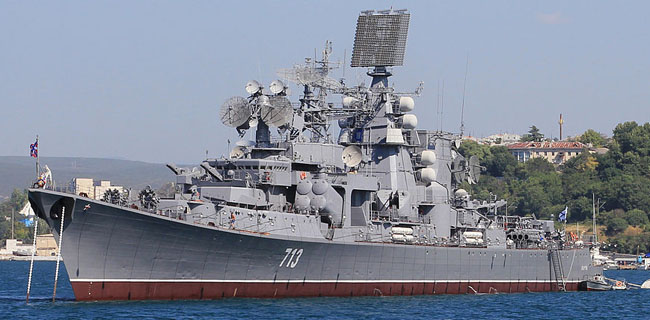
Kerch in 2012
Other options were developed notably for the modernization of project 1134-B, rated as generally successful, and they became basis for the adoption by the commission under the Council of Ministers of the USSR issued by April 20, 1972 a new ship project, not just simply modifiying the Kara design as previously assumed.
By this time, prospects for a new long-range SAM system with vertical launchers (VLS) and a new type of naval artillery mant too much modifications would have been needed. TsKB-53 began the development of project 1134-BK as well as project 1134-AK for the promising universal multi-channel SAM “Kvant” (range 80/40 km, with remote target designation). Project 1134-BK was to be fitted with no less than 64 VLS instead of the Storm, latking less space, and the the replacement of the AK-726-MR-105 by the new AK-100-MR-114 “Lev”, new FCS and radars. The development of the Kvant air defense system was abandoned for the “Fort” system derived from the Army S-300. The new system was ported on the Kara class without significant alterations of the hull and superstructure, creating the 1134-BK variant, but it was was abandoned in the benefit of the 1134-BF project, using the “Fort” air defense system (NATO ). It should be said that only Azov was fitted with 24 SA-N-6 ‘Grumble’ surface-to-air missiles.
Project 1134-BF “Fort”
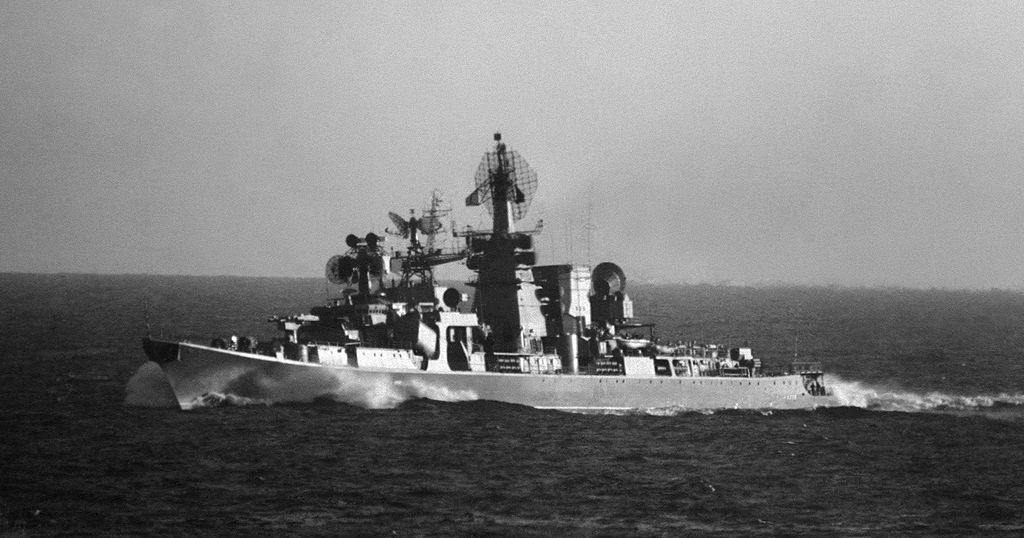
Cruiser Azov in 1988
The first and only ship which underwent the fully planned modernization of the new multi-channel air defense system “Fort” (Soviet equivalent of AEGIS) was Azov. According to the original project 1134-BF, she was supposed to have ten launchers of the new air defense system (80 missiles): six in the stern, in place of the aft SAM “Storm” and four forward. The AK-726 artillery mounts were supposed to be replaced by more powerful AK-100s, and the antenna post for the MR-114 Lev radar was installed in place of Grom radar. Already during the modernization of Azov, replacing artillery was dropped as too costly, leaving the old but reliable AK-726. Four forward launchers for the Fort air defense missile system was not even installed by fear of failure, leaving the cruiser without any effective air defense systems. This required to change the superstructure from the funnel to the helicopter hangar and internal layout as well, combat posts and ammunition storage. In connection with the expansion of the superstructure to the stern, twin torpedo tubes DTA-53-1134BF were installed for close defence. The communication equipment and datalink was the one from Project 1134-B. More.
Tests and refinement on the Fort air defense system was a lenghty process, and the final delivery of the system and adoption took place only after state tests carried with the battlecruiser Kirov. After the adoption of the upgraded project 1134-BF in 1977, Azov became the world’s only cruiser armed with three ranged missiles short, medium and long-range between the “Osa-M”, “Storm” and “ Fort”). Unfortunately her new career was short.
Modernization Projects
“Malakhit” Upgrade:
The large displacement of the Kara class led the designers to plan the installation of extra weapons if a space for it could be found. Developed by the Central Research Institute. A. N. Krylov, the modernization project involved replacing the URPK-3 “Metel” (SS-N-14 ‘Silex’) with the new P-120 “Malakhit” SCRC (SS-N-9 Siren), which at the time was just reaching mass production and were in service with nuclear submarines (project 670M – NATO Charlie II) and the project 1234 corvettes (Nanuchka-class). Decision to replace the large ASW missiles was explained by the inability to provide target designation for full range (50 km), wilt the Titan-2 was capable of issuing target designation at a distance of no more than 14 km but in real conditions often 10 km at best, thereby tasks of anti-submarine warfare at closer distances was devolved to torpedo tubes and RBU launchers. The ship would receive instead a new set of more powerful attack missiles. This upgrade was not approved however since the Malakhit and its range of 120 km no longer suited the fleet, which needed cruise missiles with a significantly longer firing range, like the US Harpoon.
“Onyx” Upgrade:
According to one of the following modernization projects, It was planned to install aft, in place of the SAM “Storm”, the new SCRC “Onyx” (NATO SS-N-26 “Strobile”) in VLS, with 48 3M55 in reserve, all anti-ship missiles. External target designation was provided by airborne observation provided by a single Ka-25Ts or two Ka-60Ts helicopters, still under development at the time. The task of self-defense rested now on a single SAM “Storm” and its 40 vectors and two SAMs “Osa-M” (40 missiles) but with the addition of the Autocannon/SAM “Kortik”, with eight combat plus two command modules (256 missiles, 24,000 30mm shells) – NATO designation CADS-N-1 Kashtan. The MR-600 Voskhod radar and MR-310A Angara radars were left but equipped with a moving target selection system and the option to replace the MR-310A by the Fregat-MA radar. The new defense system was automatic, with computerized data processing, target designation using the new Poyma datalink. The communication system was now the new “Tsentavr-M4”, and PK-10 jamming system, “Spectrum-F” warning system. For AW, the MP-401S and Start-2 were installed. For ASW warfare, the URPK-3 “Metel”, “Titan-2T” and “Vega” were left. This modernization turned out to be very expensive (51 million rubles) and long, equal to 3/4 of the cost building and entire new Kara class cruiser, so this was rejected.
“Uranus” Upgrade:
This later upgrade proposal planned the installation of the “Uran” anti-ship missile system, with 16 X-35 missiles, and a modified version of the Storm anti-ship missile system with two launchers for 80 missiles, capable of operating on low-flying targets and notably as an anti-ship missile. Instead of the Osa-M air defense system, four Kortik air defense system (128 missiles, 12,000 30-mm shells) were to be installed. The Metel complex was to be replaced by the Rastrub URK, with eight torpedo-carryin missiles, and the Titan-2 SJSC by the Zvezda-M1, without its towed device. The MR-310A Angara radar was replaced by the Fregat-MA radar, and a full modernization of the communication and EW suite. The RBU-1000 and RBU-6000 mounts were left, but equipped with new generation reactive depth charges, with an active sonar homing system. Again, the modernization cost was evaluated to 48.1 million rubles, and rejected.
Project 1134-II:
Developed in the late 1980s, project 1134-II concerned a full modernization of the cruiser “Nikolaev” deadlined in 1990, and if successful and funded, ported to the “Tashkent” at the tim under major overhail at Nikolaev shipbuilding plant 61 Kommunars. The preliminary design recuperated many of the previous options, for a more limited upgare than earlier projects, and integrating both the Onyx and Uran SCRCs. These systems were still under developmen and so instead the admiralty ordered the study of using in place the subsonic SCRC Uranus for small displacement vessels. It was capable still of a 130 km range (versus 300 km for Onyx).
As the Kara class lacked any over-the-horizon target designation, this fell again to the onboard Ka-25Ts helicopter, but given its limited autonomy and radius of action, this was less than ideal. Thus it was planned to combine efforts with a Tu-95RTs aircraft (a sub-version of the legendary “bear”) for target designation. However these were easy meat for US carrier-based fighter aircraft. Target designation by satellites coould be done in peacetime, but in wartime, it was expected satellites would be blocked or destroyed.
Global composition of the SAMs remained the same but modernized with two Shtorm-N, two Osa-MA-2 assorted with a new control system. Missile defense was increased by 2.4 times. The Voskhod radar was replaced with the Podberyozovik, enabling target designation for incoming low-flying missiles, and the new Fregat-MA radar. The Baikal-S4 system was removed for the Poyma system, as well as new EW and communications system. The Ka-25PL helicopter was replaced by the Ka-27PL, already available, and the Rastrub SAM/CIWS as well, and eight 85RU or 85RUS torpedo-carrying missiles. For ASW detection, Titan-2T and Vega were kept and later to be replaced by the Zvezda-M1. Estimated cost was 13.6 million rubles, but went in 1990 and beyond up to 108 million and due to the new conjncture in Russia, the project was cancelled.
Project 1134-1155:
Probably the more radical modernization project was to cross Project 1134-B (The Kara) with all the particularities of the Project 1155 ASW destoyers (Udaloy class), bringing combat capabilities together. After all, the hull of the Kara was larger, roomier than the Udaloys. According to this, the Storm SAM was replaced by the Kinzhal air defense system: 64 missiles, four octuple container launchers forward and same at the stern. The 76-mm artillery was replaced by four quadruple launchers with the Uran SAM. Two 100-mm AK-100 guns were installed, superfiring in line forward of the forecastle. The Metel SAM was rpelaced by a single Rastrub system, the helicopter hangar was enlarged to operate two Ka-27 helicopters. Again, the stupendous costs required in 1990, in such context, killed the project.
Final stiry is that in the 1990s, the new Russian Navly had not nearly enough funds to properly maintain the huge Soviet “legacy” fleet. So modernizatio of the already 20 years old “Kara” class went under the rug. In fact the maintenance situation deteriorated until the seven Kara class ships were forced to be decommissioned. Later the remaining ones, using cannibalized parts and minimal maintenance, approached the service limit of the fleet (25 years) and any modernization was no longer considered.
General assessment
For their time, in the early to mid-1970s, the Kara class cruisers were probably the best anti-submarine ships in the Soviet Navy, with the highest power-to-weight ratio, large fuel reserves, high autonomy and speed, great flexibility for mobility in all situation, and a powerful set of modern missiles and stae of the art communication systems and a level of automation nevers seen in the Soviet Navy so far. Their large hull combined with this automation (thus smaller crew) enabled good habitability by Soviet standards. Crew’s accomodation also for the first time received architectural care and even artistic, stylistic design. They were seen as “luxury” cruisers.
The Kara class also looked the part as missile cruisers: They had a slender, well balanced silhouette, spectacular and embodied at the time all the achievements of Soviet science, shipbuilding and defense industry. In foreign (NATO) literature, they were classified as “light cruisers” with guided missile weapons (CLG, until 1975) and after 1975 reclassed a missile cruisers (CG). The West rearlized they were not just a thord iteraion of the “Kresta” design but something entirely different. According to NATO classification the “Kara” class was inspired by the sea of the same name, more telling that the project name. The large rhull meant that a greater stability reserve was achieve and thus, the mass of combat assets and electronics reached the highest military value for any Soviet ship so far, and some US Navy specialists noted that, to the American technical standards, these cruisers were woefully “overloaded”.
According to some experts, the Kara class however had some shortcomings which appeared during near-30 years of operation and none of these were obvious when the new project was designed:
-The short range of shipborne sonar systems (unable to detect a submarine even at the range of anti-submarine weapons). This was partly resolved by the onboard helicopter
-The extreme complexity of the brand new gas turbine plant did not led to the expected fuel savings, nor the required high speed. In practice, always used their main engines increasing fuel consumption.
-The weak artillery armament, not allowing the Kara to engage even frigates. By the 1990s, artillery was seen as a “dying” weapon and all projects were cancelled.
-The URPK-3 “Metel” and later URK “Rastrub” at full range was only possible thanks to an external air or sea target designation.
-These Silex missiles had the extra disadvantage of an entry splashdown easily detected by a submarine, which could launch acoustic decoys.
-The RBU-1000 rocket launchers aft appeared redundant.
-The torpedo armament was inadequate as torpedoes were always fired in pairs. So the five-tube banks could be dispensed of or replaced by smaller twins.
The next Udaloy class had only twin tubes and no RBU-1000 launchers.
-The weight and size of the Storm SAM was also criticized.
-Only a single Ka-25 helicopter per ship was seen as too limited. The fleet back in 1967-68 was not not clear about tactical use for permanent deployment of two helicopters.
-Also in the 1970s, the Ka-25 was already obsolete and ill-adapted to chasing effectively the new generation USN Los Angeles-clas SSNs.
-Also in a way, the fact that only seven Kara class ships were ever built meant on average only five were available at all times, and so according to S. N. Mashensky, they were never enough of these for large scale, high-intensity ASW operations on several fronts.
Service History

Petropavlosk in 1982
The Kara class cruisers were posted only on the Black Sea and Pacific Fleets. Those in the Pacific experienced the greatest activity. They continuously carried out search operations in the Philippine Sea, site of combat patrols by American SSBNs. Due to their outstanding seaworthiness and combined assets, they were capable effectively to deter American SSBNs from their combat patrol zone, so much so that the fleet command at some point agreed to have all seven ships based in the Pacific. But this was of course vehementy rejected by the Black Sea Fleet command, as the Kara class ships there were also involved in the 5th operational squadron roaming both the Mediterranean and Atlantic. In total, in the late 1970s and early 1980s, four of the seven ships (Petropavlovsk, Tashkent, Tallinn, Nikolaev) only served in the Pacific Fleet.
With the arrival of Trident-1 and Trident-2 SSBNs able to launch their missiles close to US shore, and no longer from distant areas like the Philippines, by 1985, combat patrols ceased and the Kara class of the Pacific and Atlantic were now robbed of their primary task.
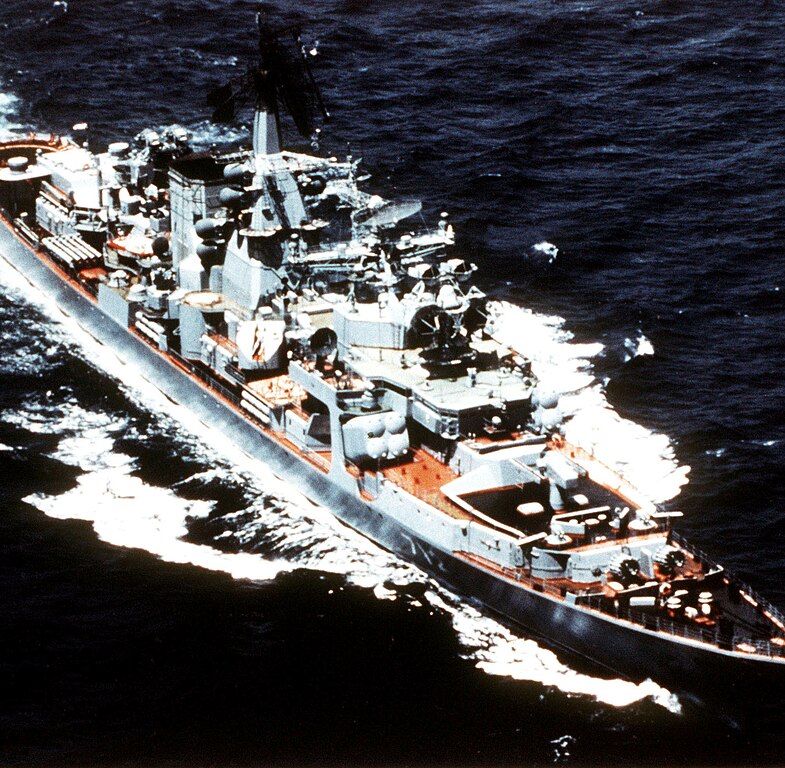
Petropavlovsk in 1984
Pacific large ships were soon given a new combat mission, in the Sea of Okhotsk, having the ability to strike the US territory from a virtual inland sea. They were conducting search operations to identify and multi-purpose nuclear submarines from combat alert areas near Soviet SSBNs routes, as well as escorting the new submarine cruisers (SSGNs) such as the Charlie II and Oscar I-II to their combat alert areas. With the arrival of the new Minsk and Novorossiysk helicopter cruisers in the Pacific, the Kara were planned for a modernization as ocean escort ships. The Northern Design Bureau carried out a number of studies (seen above) but close to the collapse of USSR, this was never realized.
The Kara class also carried out military-political missions, like Tallinn protecting the Soviet-friendly government of the Seychelles, and presence in various “hot spots”, off warring countries, shadowing US or NATO ships there and enforcing the constant military presence of the USSR.
After 1991, the Kara class saw no activity. Gradually withdrawn only Kerch was maintained (refit in 1993) make a few long-distance cruises, notably in the East China and South China Seas in 1993, or to Greece, Piraeus during the visit of President Yeltsin to Greece in 1994, as well as the ports of Varna, Messina and Cannes in France in 1998. Kerch was the last Kara class in activity. She was decommissioned as recently as 15 February 2020 (three years ago as these lines are written) and scrapped in Sevastopol.
 Nikolaev
Nikolaev

The laying of the Nikolayev, the shipyard’s namesake, took place on June 25, 1968 at 61 Communards (the name by the way was a reference to the French commune’s 1870 executed early “communists”).
On August 13, 1969, she was started and by December 19 launched, entering service on December 31, 1971. On February 8, 1972 she joined the 30th division, Red Banner Black Sea Fleet.
The sortie outside the Black Sea took place on March 1, 1973. She went into the Mediterranean Sea, Atlantic, making many port calls. By late September to early October, she provided assistance to Egypt during the Israeli-Arab war. She was back to Sevastopol in November. On April 9, 1984, she was transferred to Pacific Fleet. By November 11, 1987, she returned to Nikolaev for a major overhaul, but after the collapse of the USSR, it was cancelled. Seeing little activity by October 29, 1992, she was stricken from the lists and by December 31 discarded, sold on August 10, 1994 to an indian scrapyard, towed there for BU. The cruiser Nikolaev appeared in the Soviet moved “The Truth of Lieutenant Klimov”.
 Ochakov
Ochakov
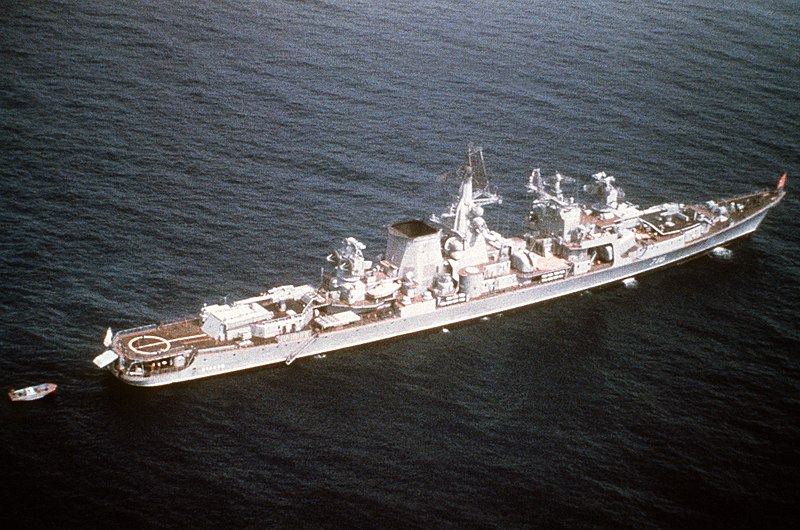
Ochakov was laid down at the 61 Kommunars, Nikolaev as S2002 on December 19, 1969. Her “luck coin” on the keel was installed by the Commander-in-Chief of the USSR Navy, Admiral S. G. Gorshkov himself during the laying down ceremony. On December 25 she was properly started her name given from the capture of the Achi-Kale fortress in 1788. She was launched April 30, 1971, entered service on November 4, 1973, and on the 28th reported to the Black Sea Fleet, 30th division. In March 1974, she took part in exercises as part of the protection screen of the helicopter cruiser Moskva.
Initially her pennant 522 (1973), was changed to 539 (1974-1975), 526 (1975-1976), 527 (1977), 509 (1978), 529 and 716 ( 1979), 175 (1980), 530 (1977 and 1983), 745 (1979), 703 (1986-1987), 714 (1988-1989), 707 (1990). This was a common trick to deceive NATO-US Intel about her coming and going.
Her first combat sortie in the Mediterranean Sea was in December 24, 1974, to May 12, 1975, making a port call to Annaba in Algeria). She made nine long cruises, participated in exercises “Ocean-75”, and “Crimea-76”. She was awarded the excellence pennant “For courage and military prowess”. In 1977, 1979 and 1986, Ochakov was declared the best ship in the Navy.
Port called she made between 1978 and 1990 were Latakia (Syria), Rijeka (Yugoslavia), Toulon (France), Varna (Bulgaria), Havana (Cuba), Istanbul (Turkey), Split (Yugoslavia), Constanta (Romania) and Taranto (Italy).
From March 26, 1980 to July 18, 1984, she had a major overhaul at the Sevastopol NyD. In 1985, he took part in the movie “Solo Voyage”. In 1991, she had a new overhault in Sevastopol, but after the collapse of the USSR, it was never completed and in 1993, a serious fire broke out. Her planned return in operation scheduled for 2004-2005 never happened and by October 20, 2008, she was towed and laid up near Troitskaya Bay in Sevastopol. On August 20, 2011, she was decommissioned, and on the night of March 5-6, 2014, along with three decommissioned ships, she was flooded by the Russian military at the entrance to Lake Donuzlav, to blockade the Ukrainian Navy entering.
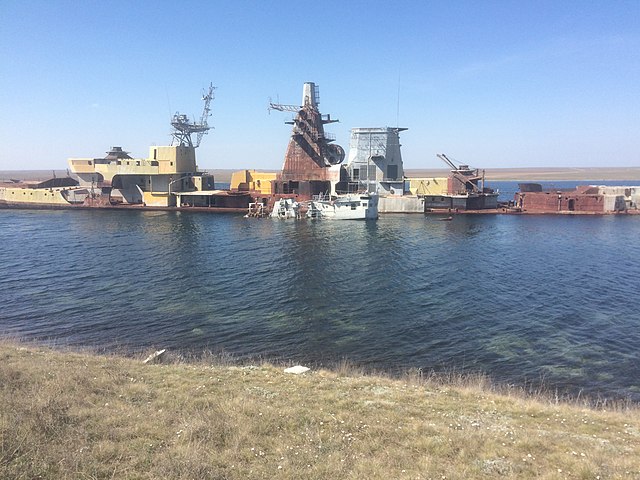
Ochakov in Donuzlav, 2017
Ochakov was lying under 12 meters, turned 70 degrees. She was eventually raised by EPRON withing 162 days, and operation involving 13 ships and 35 diver. Large pontoons, sealing, pumping (over 300,000 cubic meters) had her raised on September 1, moved out to free passage to the bay and she was lightened. On September 11, the operation was completed sh was towed to Inkerman for disposal (still there to this day).
 Kerch
Kerch
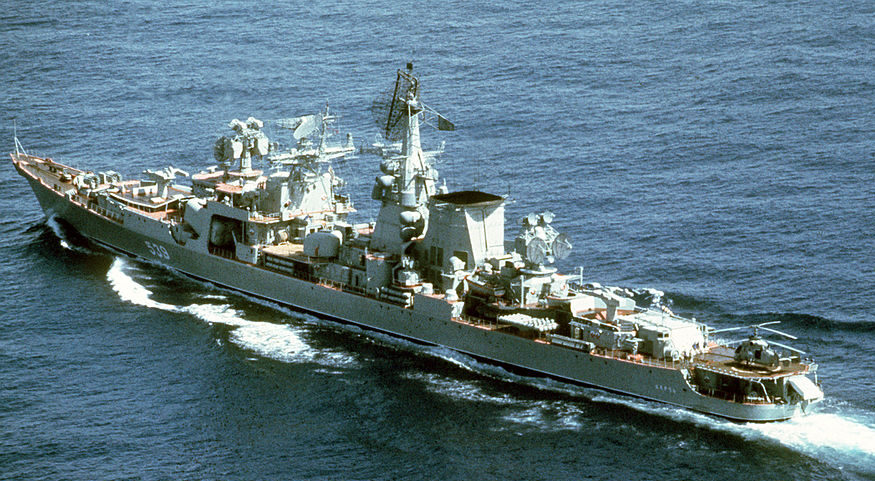
Kerch ship was ordered on December 25, 1969, laid down at Nikolaev on April 30, 1971 (serial S-2003), launched on July 21, 1972, commissioned on December 25, 1974 and assighed to the 70th brigade of anti-submarine ships, 30th division, Black Sea Fleet.
After training and shakedown, Kerch was declared in combat readiness, and on January 5, 1976 entered the Mediterranean Sea. She was present during the war in Lebanon, demonstrating Soviet military presence in the eastern Mediterranean. On July 24, she was back to Sevastopol. She returned in theMediterranean from December 1, 1977 to June 28, 1978 and from May 3 to October 15, 1979. In 1978, the she was awarded the excellence prize for missile training, and the following year the pennant “For courage and military prowess”. In 1980, she was awarded the challenge Red Banner. On October 16, 1981, she was visited while at Sevastopol, by the Deputy Minister of Defense Marshal K. S. Moskalenko.
From September 10 to October 6, 1982, Kerch participated in “Shield-82” exercises, and from September 3 to 20, 1983 in more naval exercises in the Kerch Strait as flagship, CIC Soviet Navy. From March 12 to March 21, 1984 she took part in Soyuz-84 exercises, and from August 1 to 9, visited Varna (Bulgaria). After resupplying as she was ready to depart, just a day before leaving, one midshipmen, failed to check for oil, and the main power plant failed to start, blocked. This was resolved and she could return to port. She was drydocked at “Sevmorzavod” yard for repairs and modernization from 1985 to March 1988.
Gas turbine units were replaced while URK-5 Rastrub PLRK and Shtorm-N air defense systems were installed as well as the Tsunami-BM Satcom system, Cyclone-B, plus new 45-mm salute guns, Voskhod radar replaced by the Podberyozovik radar. She made her shakedown cruise and stopped at Istanbul, and from August 11 to 15, 1988, returned to Varna. In 1990, under the CiC flag she stopped in Odessa and as flagship of 30th DiPK returned to Varna. Before the collapse of the USSR, on May 25 – October 25, 1991, she made her last sortie, in the black sea.
From February 4 to February 16, 1992, she became flagship of the 5th OPESK, participating in joint exercises with ships of the US 6th Fleet (yes you read well !).
When berthing on March 1, 1993, she crashed into the concrete wall of the 14th berth at Sevastopol Naval Base. The stern required two-weeks of repair. But given her generlal slated she was simply left in S. Ordzhonikidze shipyard for a long time.
After her modernization in 1993, a refrigerator caught fire in the officer’s canteen, discovered only after 25 minutes, but the superstructure did not have time to catch fire and the situation was under control. From June 16 to July 10, 1993, Kerch saw her very last combat service, while at sea she made contact twice June 21 and 23 with US nuclear submarines. She won also the Prize of the Civil Code of the Russian Navy for missile training.
In 1994, “Kerch” made another 17-day cruise to the Mediterranean carrying President of Russia B. N. Yeltsin to Greece. From 18 to 22 August 1996 she visited Varna. In November 1998 as flagshio, Deputy Commander of the Black Sea Fleet Rear Admiral A.V. Kovshar she visited Cannes and Messina.
In 2005, she underwent routine repairs at Novorossiysk Shipyard having one turbogenerator replaced, hull and bottom fittings repaired, a fresh coat of paint, and left shaft line repaired as well. In 2006, she had a maintenance of her Podberyozovik radar. Docked at Sevmorzavod, her MR-700 Podberyozovik radar was overhauled and electronics replaced.
In June 2011, she made a two weeks shakedown and training cruiser in the Black Sea, shadowing the US Navy cruiser USS Monterey.
Kerch traveled more than 180,000 nautical miles during anti-submarine operations, maintaning some times up to eight hours of contact with foreign nuclear submarines and for 40 hours with diesel ones.
From June to November 2014 she underwent her last overhaul. She was indeed supposed to replace Moskva as permanent flagship of the Black Sea Fleet. During repairs on November 4, 2014, a fire broke out at, damaging aft compartments. The commission investigating the incident decided to write her off, putting her on the disposal lost in 2015. It was temporarily postponed to serve as training ship for seafarers and floating HQ of the Black Sea Fleet. By August 18, 2015, the Chief of the General Staff decided to have her stricken from the Black Sea Fleet and sent to the military museum of the Black Sea Fleet.
In November 2016, her main engines were to be transferred to another ship of the Black Sea Fleet, Ladny. In June 2019, it was announced she would be scrapped in 2020 and by June 26, the sell was canceled.
On February 15, 2020, she was officialy decommissoned and by April 24, she was assigned to Inkerman for scrapping. It went on from August 2020, to 2022 (completion).
 Azov
Azov

Azov was ordered by January 4, 1972, laid down on July 21 as S2004, launched on September 14, 1973, commissioned on December 25, 1975. By February 19, 1976 she was assigned to the Black Sea Fleet.
On October 5-7, 1976, she was inspected notably by the Deputy Minister Kirill Moskalenko.
No records for her service in the 1970s and 1980s. In 1990 she made a last Mediterranean cruise, visiting in January 22-26, 1990 Piraeus, crossed the Atlantic and by June 25-July 1, 1990 visited Havana (Cuba) and at her return, by June 24-28, 1991 Toulon (France) and by August 15-19, 1991 Constanta (Romania) while back in the Black sea.

“Azov” was chosen for modernization as the only ship fitted with the new experimental AEGIS-like system “Fort”, project 1134-BF. Ten launchers (80 missiles) at the stern and bow were planned, AK-100s guns, new MR-114 Lev radar. However the AK-726 were left and the four forward launchers of the Fort system not installed either. The project was upgraded as 1134-BF and she ended with short-range, medium and long-range (“Osa-M”, “Storm” and “Fort”) missile systems between July 18, 1984 and February 21, 1985. In 2000, she was stricke, sold and BU from June 2002 at Inkerman.
 Petropavlovsk
Petropavlovsk
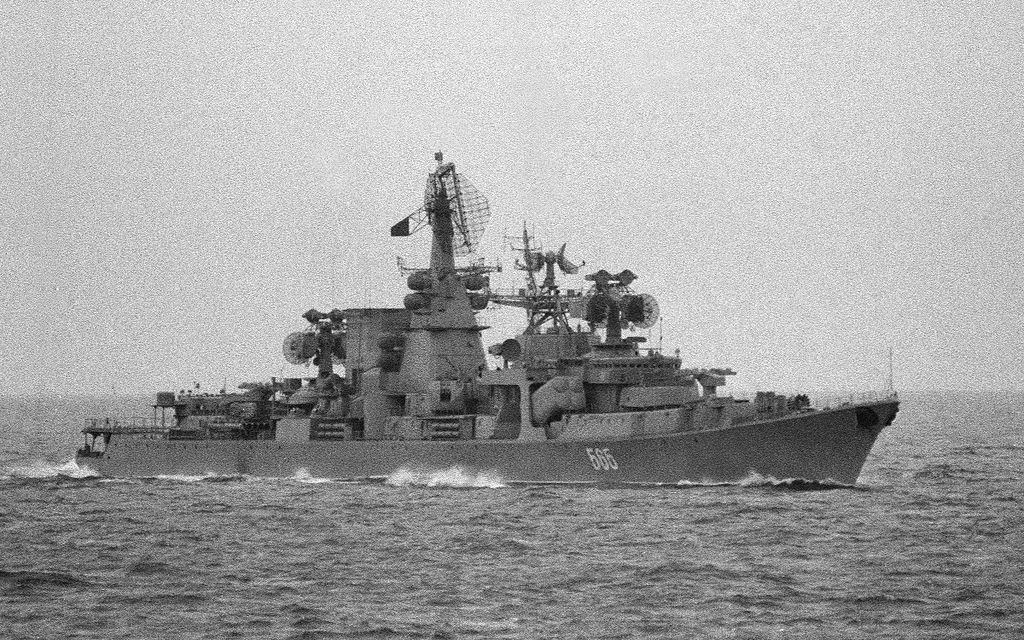
Construction of Petropavlovsk started on September 9, 1973 in Nikolaev, launched in November 22, 1974 and completed on December 29, 1976 entered service. By February 5, 1977 she was commissioned into the Pacific Fleet.
From February 24, 1979 to July 3, 1979, she was part of a task force around Minsk (project 1143.2) and Tashkent large anti-submarine helicopter cruisers, which departedSevastopol, rounded Africa to Vladivostok, stopping at Luanda (Angola) and Maputo (Mozambique) as well as Port Louis (Mauritius). In 1980, her crew was awarded the pennant of the Minister of Defense “For courage and military prowess shown in sea voyages while performing military service.” She became HQ during the salvage of the downed South Korean Boeing shot down on September 1, 1983 near Moneron, causiong such a western uproar.
In June 1994, she was decommissioned and on August 30, was transferred to the 44th ASW brigade, with the 48th and 201th brigade, 10th Division, Pacific Fleet based in the Golden Horn Bay. In 1996, she was disarmed and on May 26, 1997 stricken. By June she was sold to India and towed for BU.
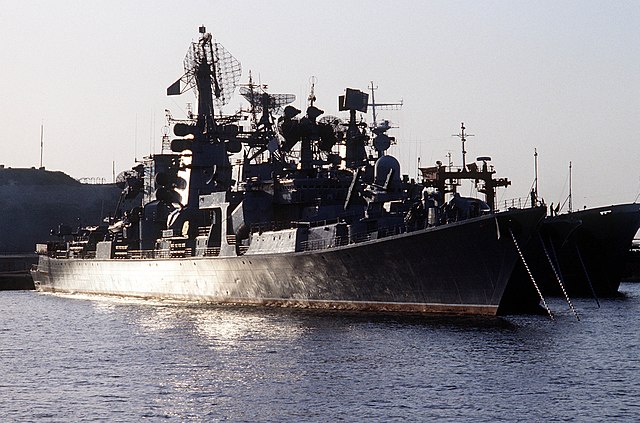
 Tashkent
Tashkent
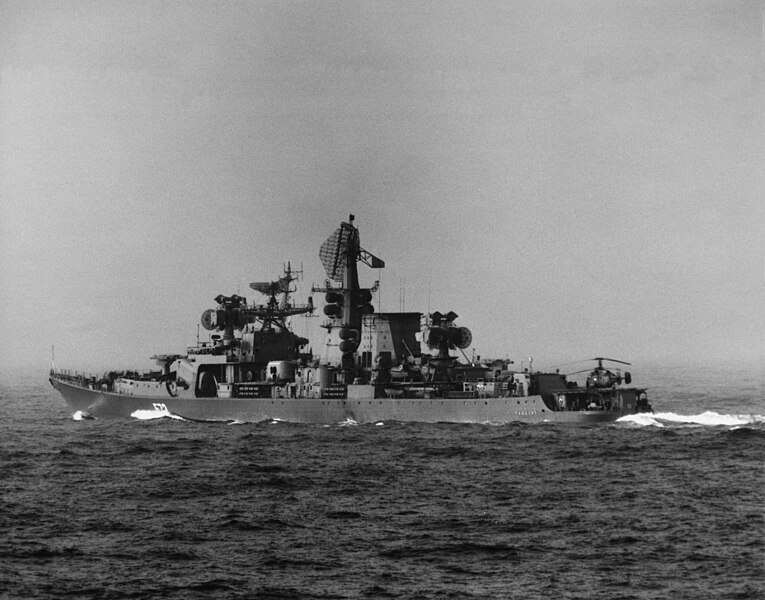
On July 5, 1974, Tashkent was ordered. She was laid down on November 22, 1974, as S2006, entered service on December 31, 1977. By February 17, 1978, she joined the Pacific Fleet, after temporary service with the Black Sea Fleet. On February 24, 1979 to July, 3, she made her trip from Sevastopol to Vladivostok.
On December 20, 1988, she returned in Nikolaev for a major overhaul, suspended after the collapse of the USSR on July 3, 1992. On October 29 she was decommissioned, stricke, and by August 10, 1994 sold to India for BU.
Project 11347 modernization with the “Caliber” complex and RLC “Monument”, Shtorm-N, Osa-MA-2 and new control system, AP “Fregat-M”, RLC “Forum”, SOI MRO-550 “Floodplain-M”, Poyma system, new EW, was never carried out as too costly.
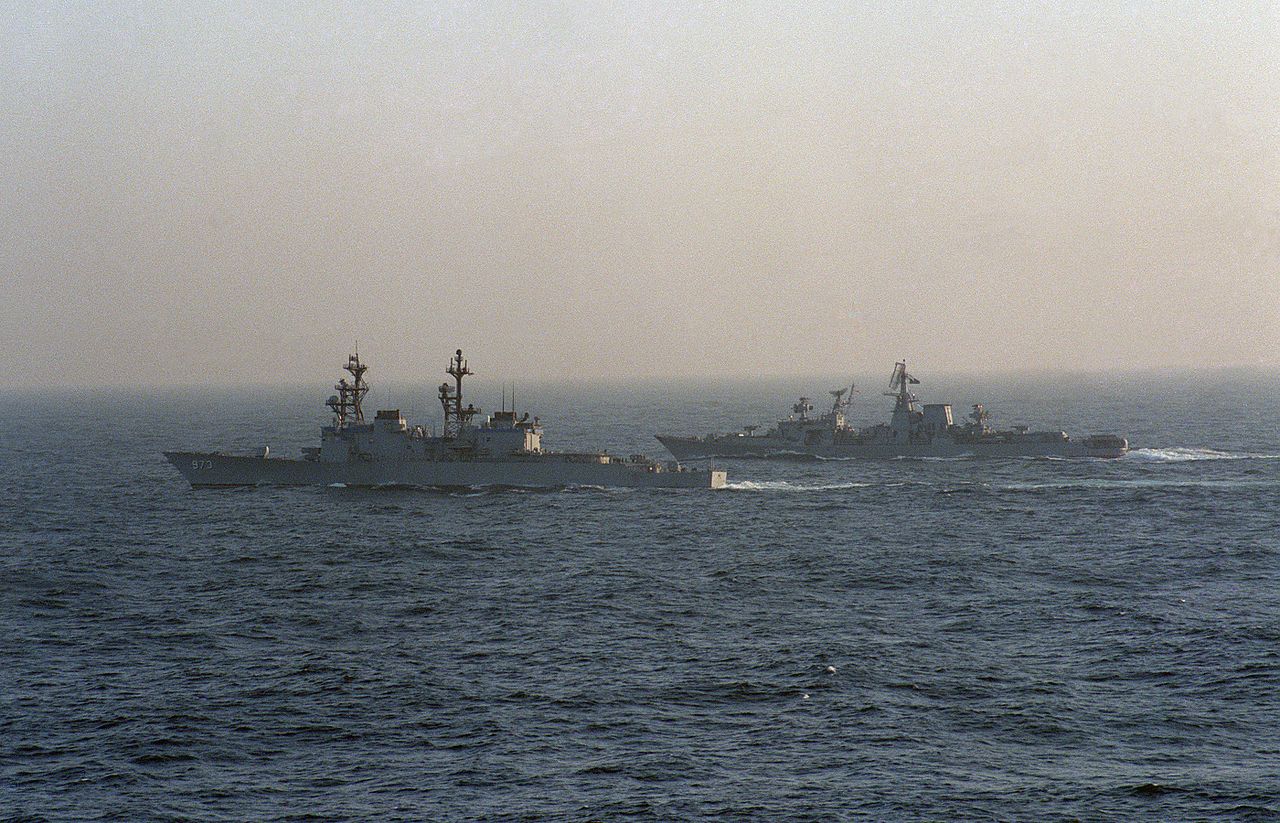
Tashkent shadowing USS John Young in 1984
 Tallinn
Tallinn
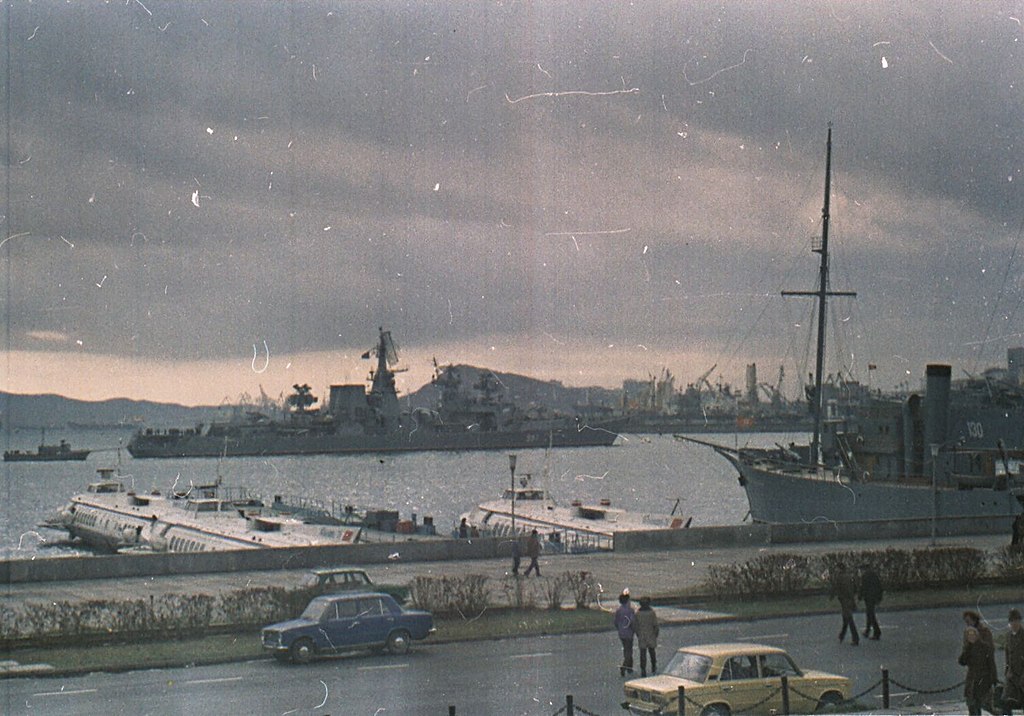
Tallinn in Vladivostok, 1982
Talinn was ordered on May 7, 1975, laid down on November as S2007, launched November 5, 1976, making her sea trials on November 17, 1979 and commissioned on December 31.
On March 28, 1980 she integrated the 175th ASW brigade, 10th Division, Pacific Fleet.
As she was travelling to the Pacific Ocean, Tallinn (under commander of Cdr. Yuri Ustimenko) she hosted the headquarters of the 85th OPBNK (Rear Admiral G. I. Smirnov). En route she stopped in Port Louis when learning of a coup in November 26-27 in the Republic of Seychelles. By November 28, Letuchy arrived at Victoria, soon joined by Tallinn which evacuated the Soviet embassy and offered support to the government, watched by the French frigate Victor Schoelcher, also in support of the President. On December 13-17, she ships resupplied at Maputo and returned to Victoria until the situation was stabilized. From February 16 to February 20, 1984, she stoppe at Massawa, Ethiopia.
On March 1, 1985, she joined the 183rd Brigade and on 13-17 August 1985 visited Wonsan in North Korea. On 12-16 March 1986 she was in Djibouti. by January 1989, she was transferred to the 201st Brigade.
In 1990, she was overhauled Dalzavod, suspended as USSR ceased to exist. From March 1991, she was listed in the 48th division of anti-submarine ships and by September 1992, renamed “Vladivostok”.
On July 5, 1994, she was decommissioned from the Pacific Fleet. Later stricken, she was sold by May 1996 to India for scrapping.
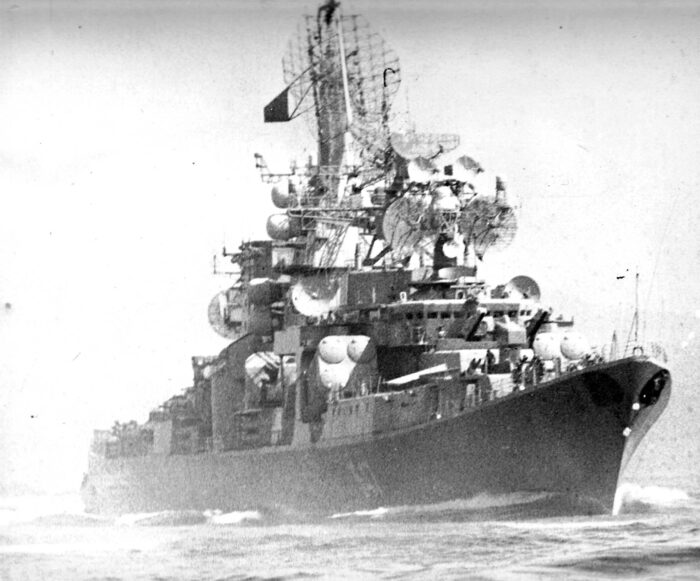
Tallinn during her sea trials, showing her prow and electronics
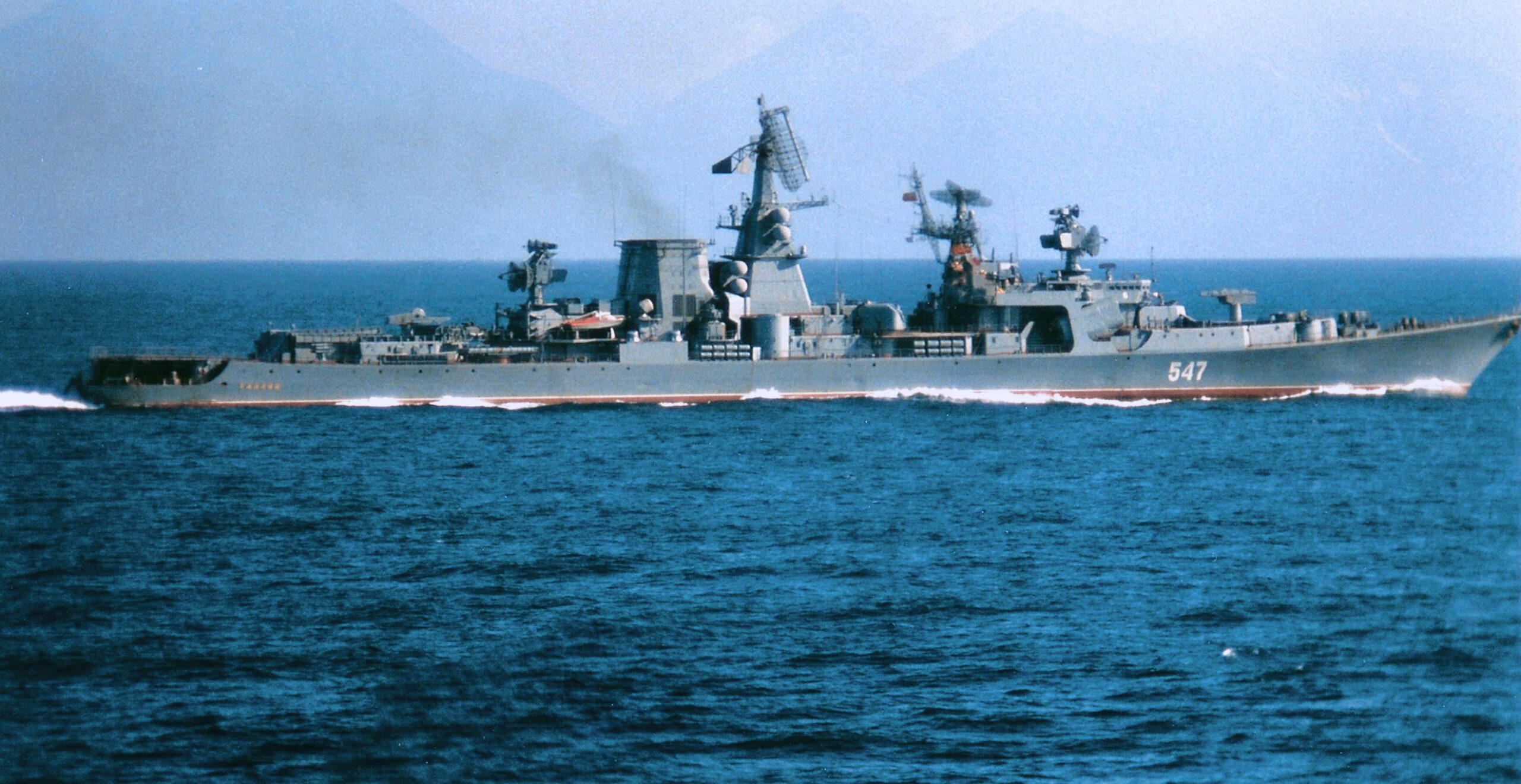
Tallinn in the 1980s, HD photo
Note: First published on Oct 17, 2017, revised 05/03/2023
Read More
Books
Chant, Chris (2004). Warships Today. Summertime Publishing Ltd. p. 98.
Gardiner, Robert, ed. (1995). Conway’s All the World’s Fighting Ships 1947–1995.
Gardiner, Robert; Chumbley, Stephen; Budzbon, Przemysław (1995). Conway’s All the World’s Fighting Ships 1947–1995.
Аверин А. Б. Адмиралы и маршалы. Корабли проектов 1134 и 1134А. — М.: Военная книга, 2007.
Апальков Ю. В. Корабли ВМФ СССР. Справочник в 4 томах. — СПб.: Галея Принт, 2005. — Т. III.
Janes Fighting Ships 1981-82 / Moore, John Evelyn. — London, New York: Janes Publishing Company, 1982.
Moore, John Evelyn. Soviet Navy today. — New York, U.S.A.: Stein and Day, 1976.
Links
Kara class EN
Kara class ru.wikipedia.org/
On ship.bsu.by/
On globalsecurity.org/
on flot.sevastopol.info/
on russianships.info
on military-today.com/
On ww2.dk/
Videos
Model Kits
General Query on scalemates
More enormous is the Southern Cross Models N° 72-Kara | 1:72.
Review on modelwarships.com kara class Kombrig 1:700

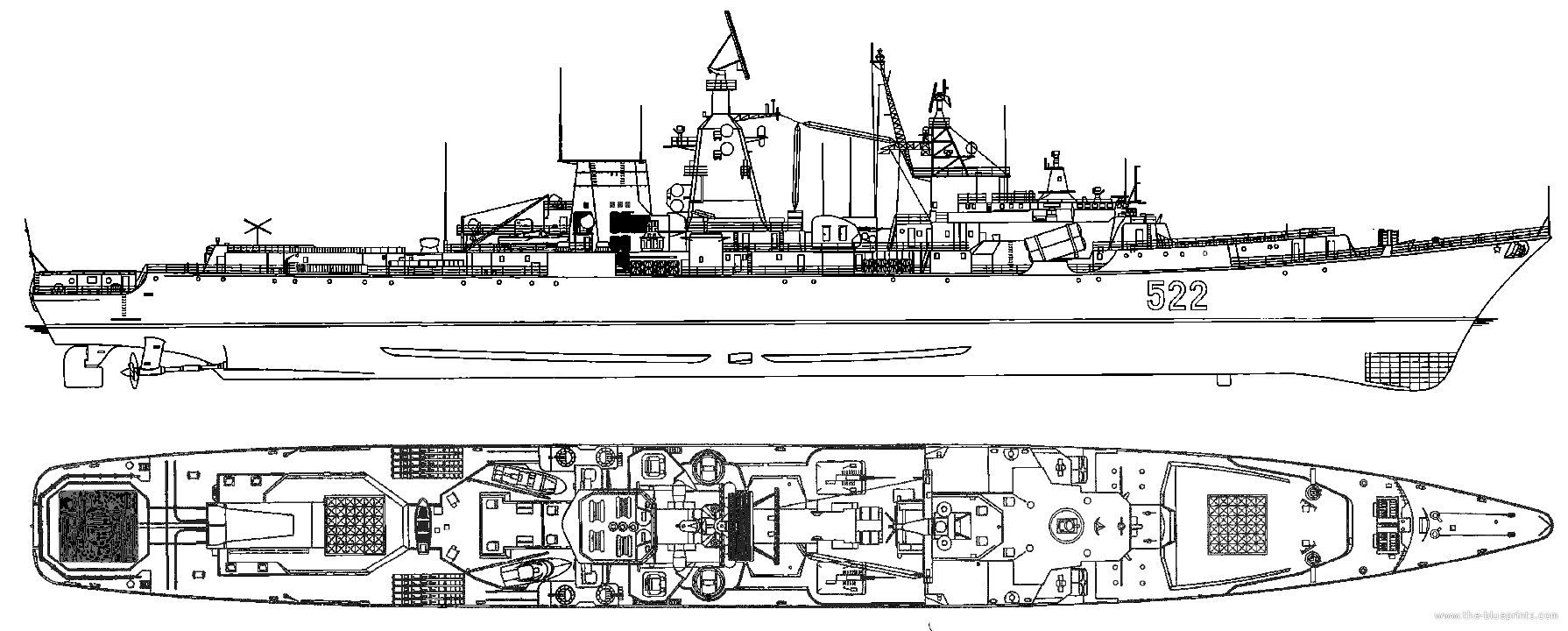
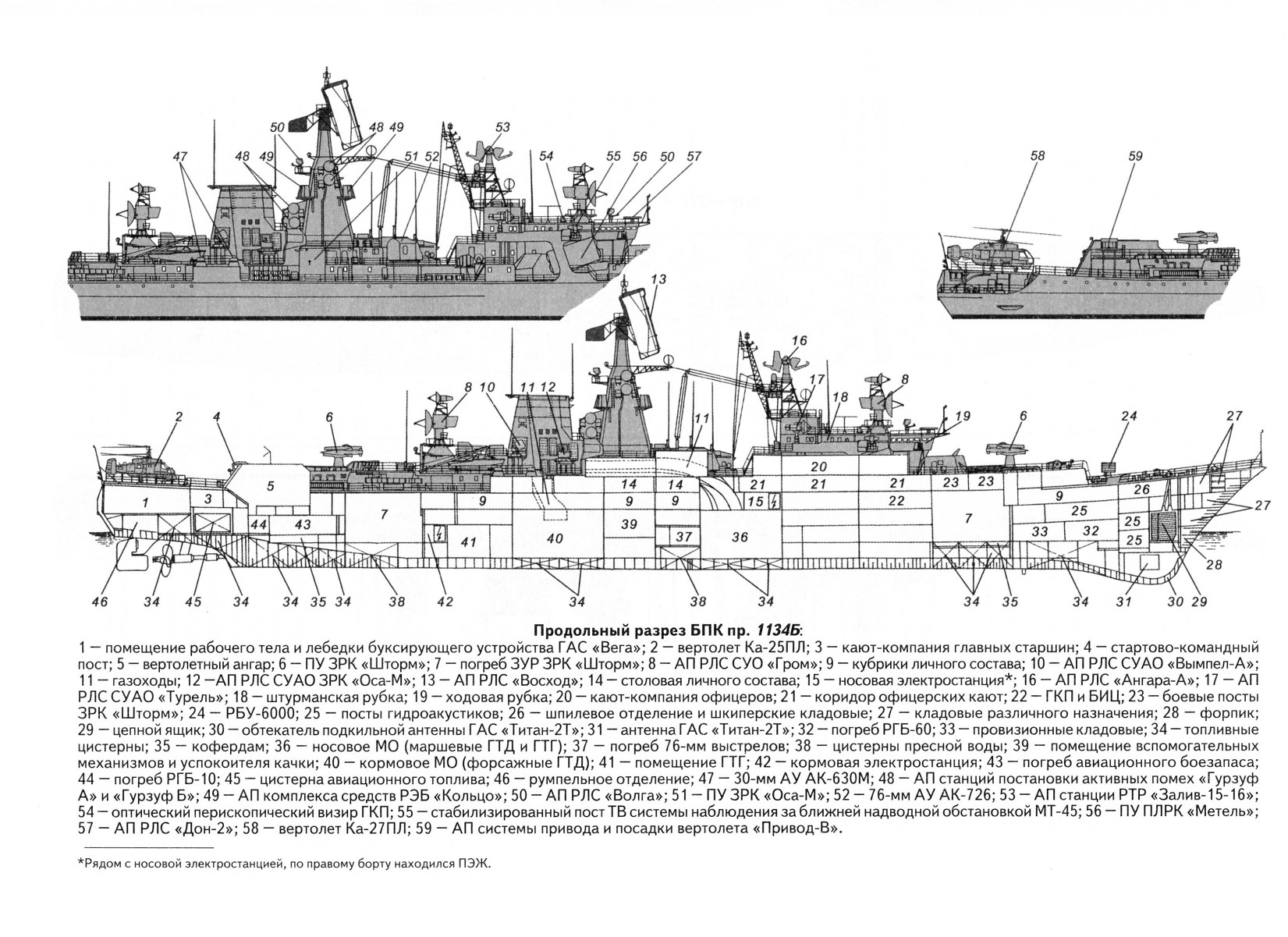
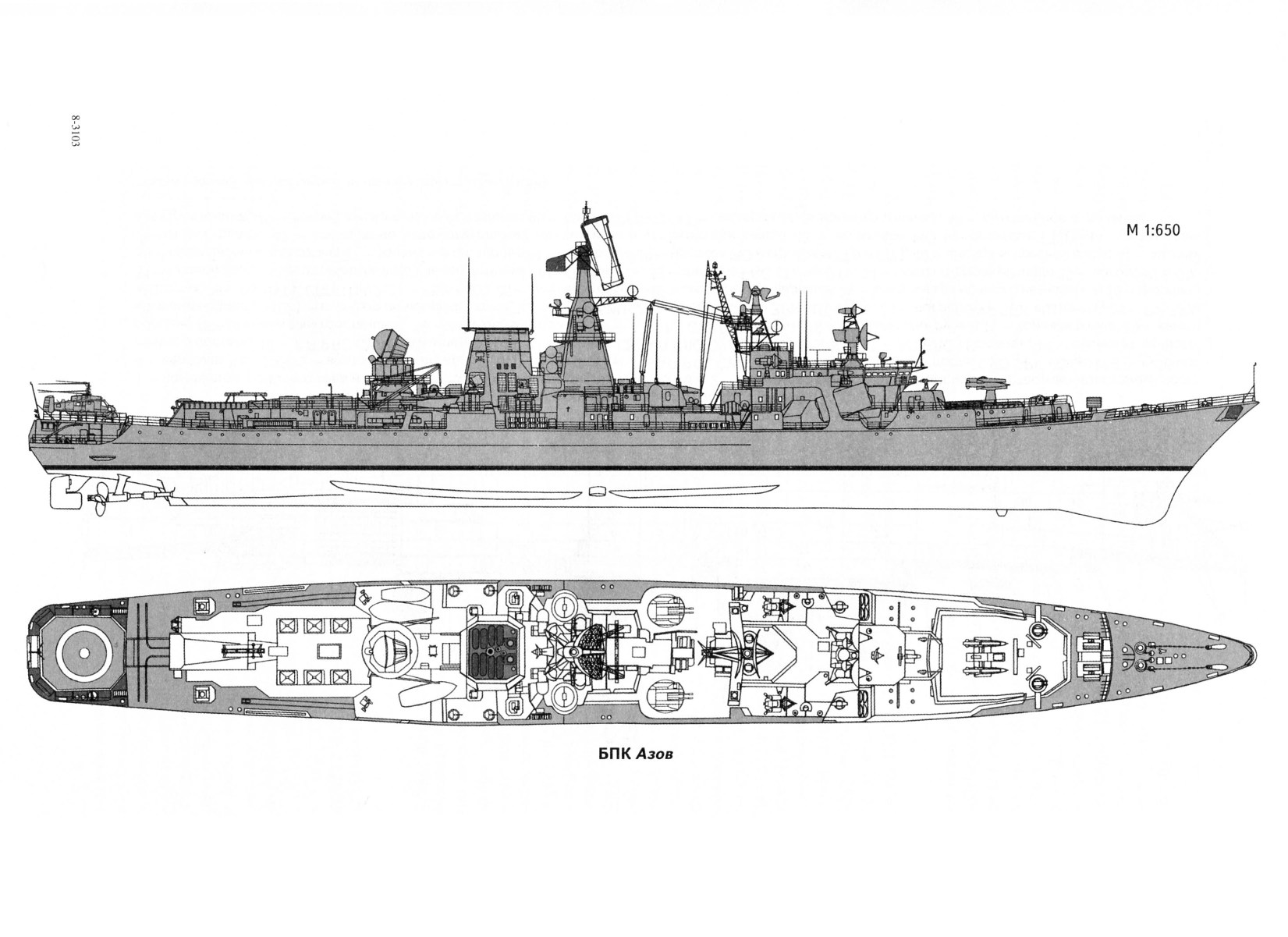
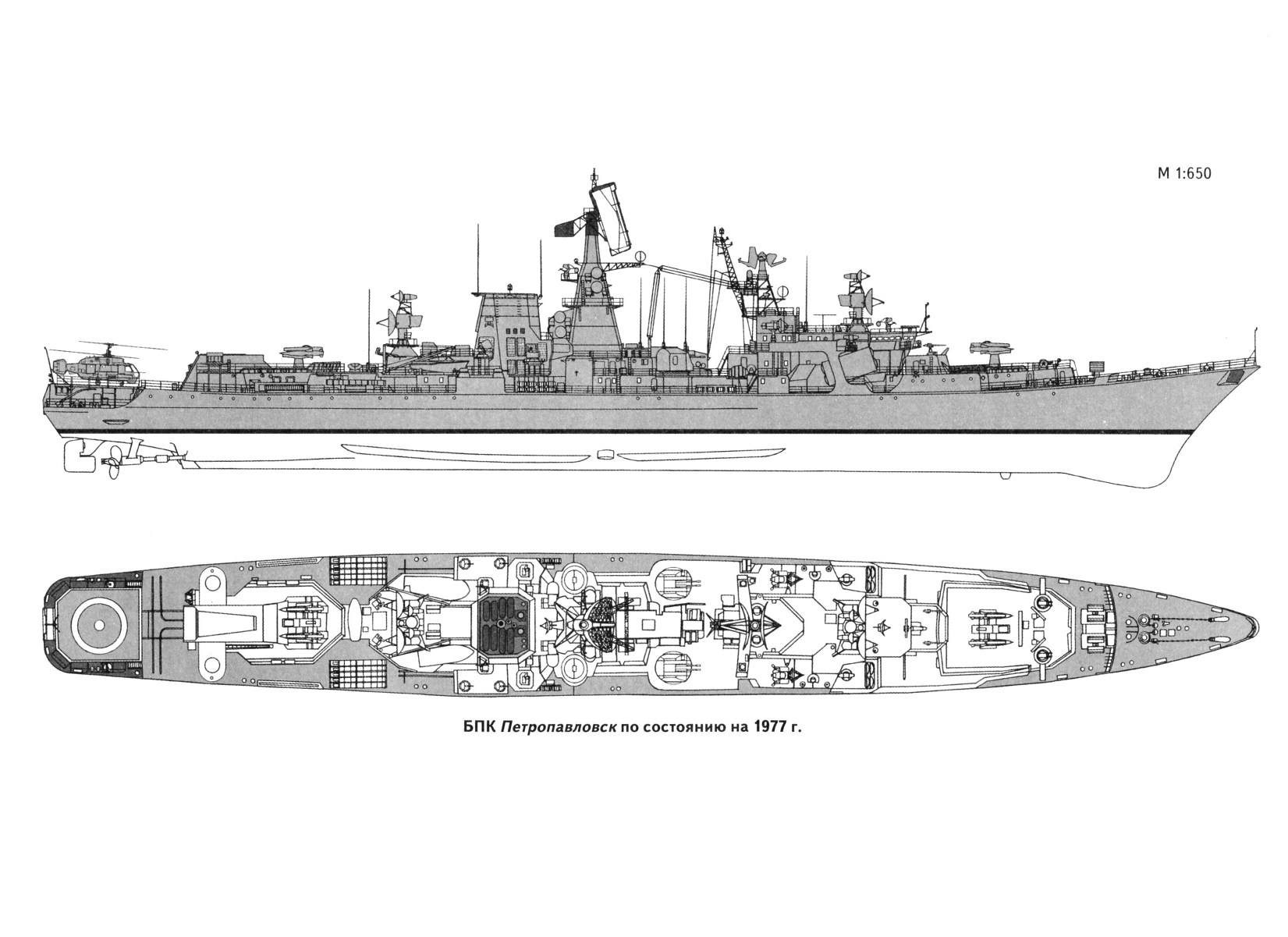
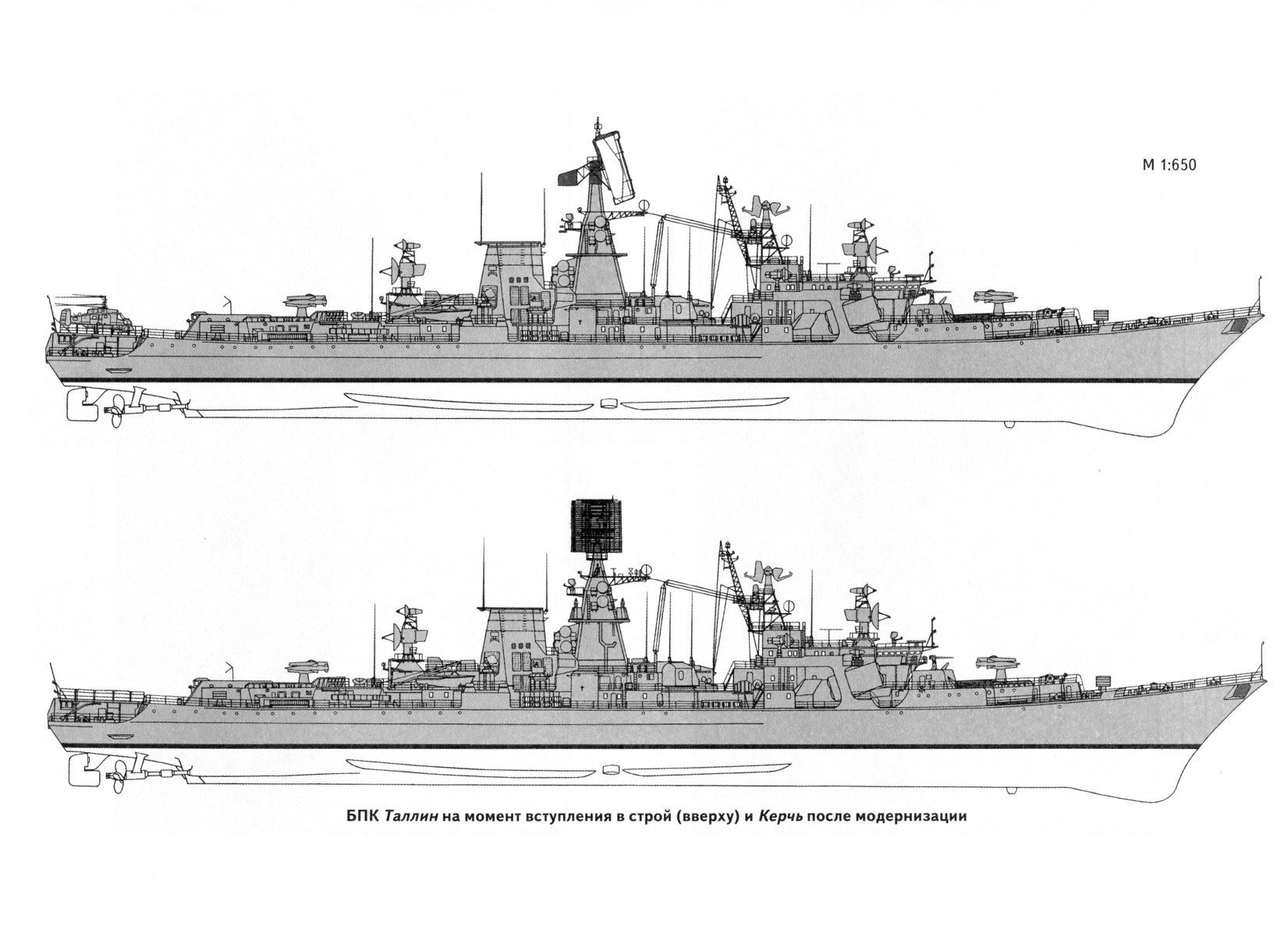
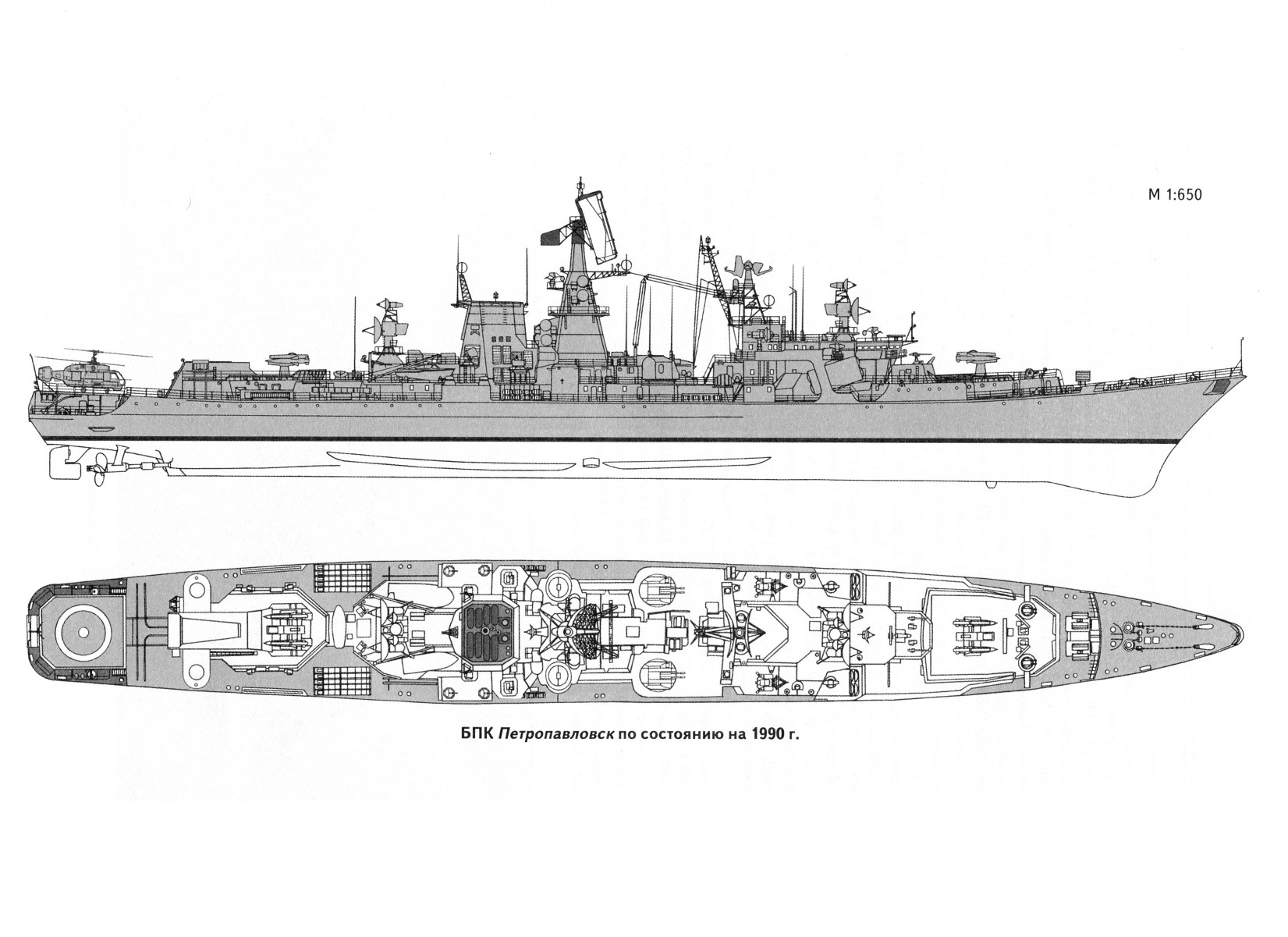
 Latest Facebook Entry -
Latest Facebook Entry -  X(Tweeter) Naval Encyclopedia's deck archive
X(Tweeter) Naval Encyclopedia's deck archive Instagram (@navalencyc)
Instagram (@navalencyc)





 French Navy
French Navy Royal Navy
Royal Navy Russian Navy
Russian Navy Armada Espanola
Armada Espanola Austrian Navy
Austrian Navy K.u.K. Kriegsmarine
K.u.K. Kriegsmarine Dansk Marine
Dansk Marine Nautiko Hellenon
Nautiko Hellenon Koninklije Marine 1870
Koninklije Marine 1870 Marinha do Brasil
Marinha do Brasil Osmanlı Donanması
Osmanlı Donanması Marina Do Peru
Marina Do Peru Marinha do Portugal
Marinha do Portugal Regia Marina 1870
Regia Marina 1870 Nihhon Kaigun 1870
Nihhon Kaigun 1870 Preußische Marine 1870
Preußische Marine 1870 Russkiy Flot 1870
Russkiy Flot 1870 Svenska marinen
Svenska marinen Søværnet
Søværnet Union Navy
Union Navy Confederate Navy
Confederate Navy Armada de Argentina
Armada de Argentina Imperial Chinese Navy
Imperial Chinese Navy Marinha do Portugal
Marinha do Portugal Mexico
Mexico Kaiserliche Marine
Kaiserliche Marine 1898 US Navy
1898 US Navy Sovietskiy Flot
Sovietskiy Flot Royal Canadian Navy
Royal Canadian Navy Royal Australian Navy
Royal Australian Navy RNZN Fleet
RNZN Fleet Chinese Navy 1937
Chinese Navy 1937 Kriegsmarine
Kriegsmarine Chilean Navy
Chilean Navy Danish Navy
Danish Navy Finnish Navy
Finnish Navy Hellenic Navy
Hellenic Navy Polish Navy
Polish Navy Romanian Navy
Romanian Navy Turkish Navy
Turkish Navy Royal Yugoslav Navy
Royal Yugoslav Navy Royal Thai Navy
Royal Thai Navy Minor Navies
Minor Navies Albania
Albania Austria
Austria Belgium
Belgium Columbia
Columbia Costa Rica
Costa Rica Cuba
Cuba Czechoslovakia
Czechoslovakia Dominican Republic
Dominican Republic Haiti
Haiti Hungary
Hungary Honduras
Honduras Estonia
Estonia Iceland
Iceland Eire
Eire Equador
Equador Iran
Iran Iraq
Iraq Latvia
Latvia Liberia
Liberia Lithuania
Lithuania Mandchukuo
Mandchukuo Morocco
Morocco Nicaragua
Nicaragua Persia
Persia San Salvador
San Salvador Sarawak
Sarawak Uruguay
Uruguay Venezuela
Venezuela Zanzibar
Zanzibar Warsaw Pact Navies
Warsaw Pact Navies Bulgaria
Bulgaria Hungary
Hungary

 Bundesmarine
Bundesmarine Dutch Navy
Dutch Navy Hellenic Navy
Hellenic Navy Marina Militare
Marina Militare Yugoslav Navy
Yugoslav Navy Chinese Navy
Chinese Navy Indian Navy
Indian Navy Indonesian Navy
Indonesian Navy JMSDF
JMSDF North Korean Navy
North Korean Navy Pakistani Navy
Pakistani Navy Philippines Navy
Philippines Navy ROKN
ROKN Rep. of Singapore Navy
Rep. of Singapore Navy Taiwanese Navy
Taiwanese Navy IDF Navy
IDF Navy Saudi Navy
Saudi Navy Royal New Zealand Navy
Royal New Zealand Navy Egyptian Navy
Egyptian Navy South African Navy
South African Navy






























 Ukrainian Navy
Ukrainian Navy dbodesign
dbodesign